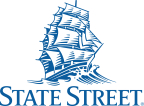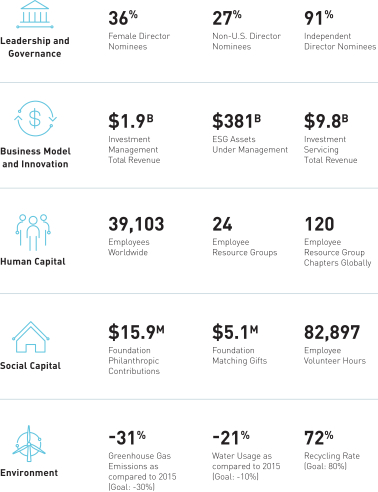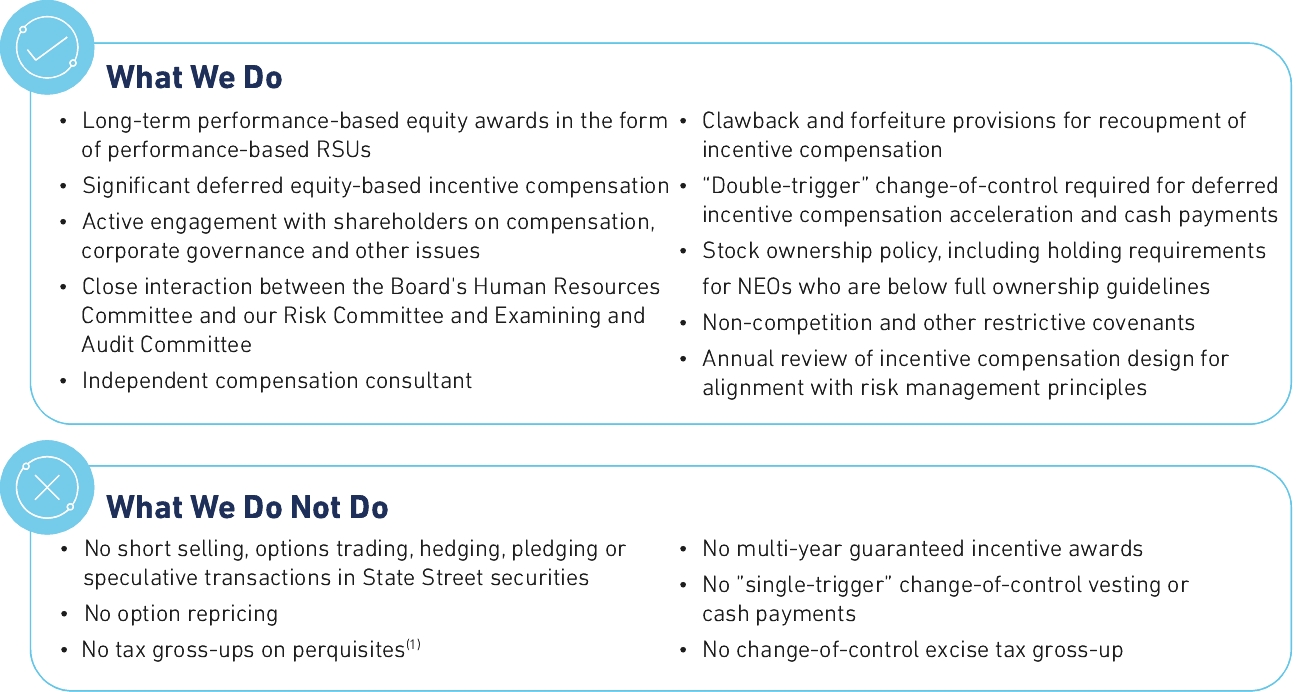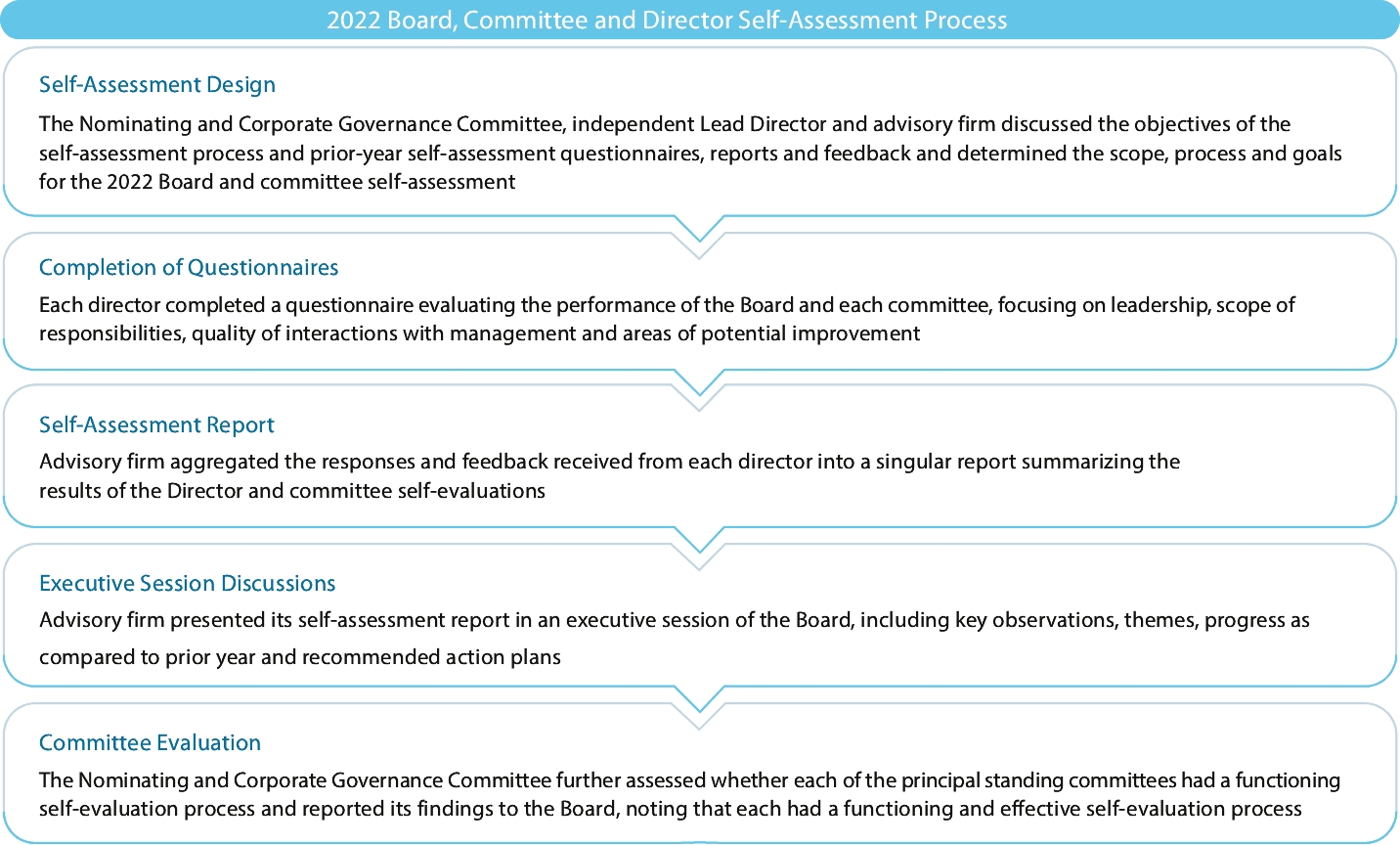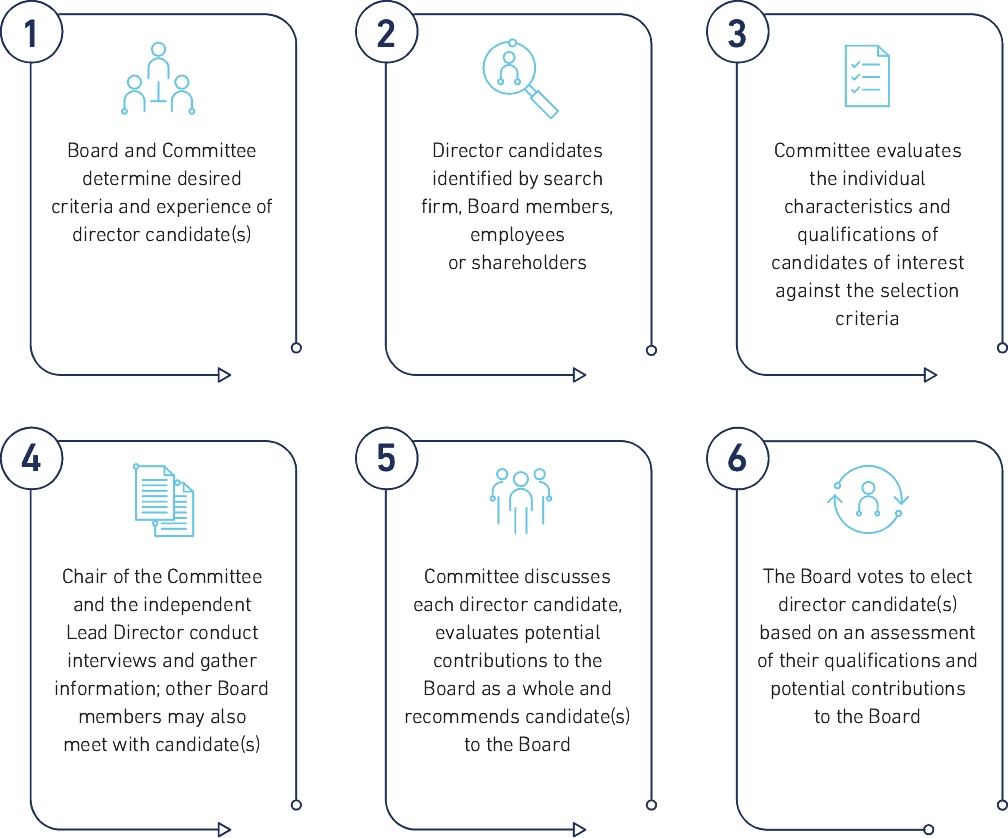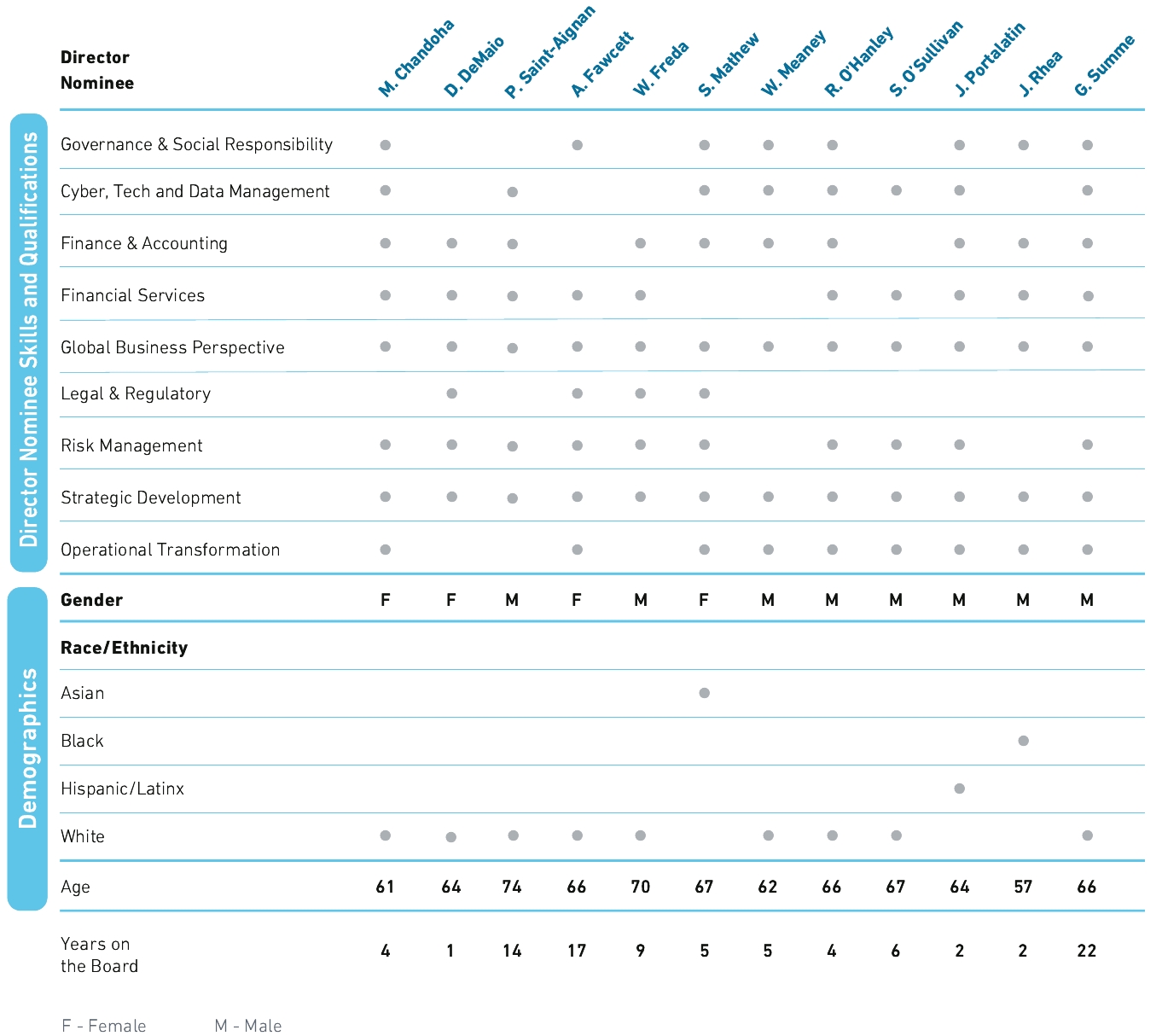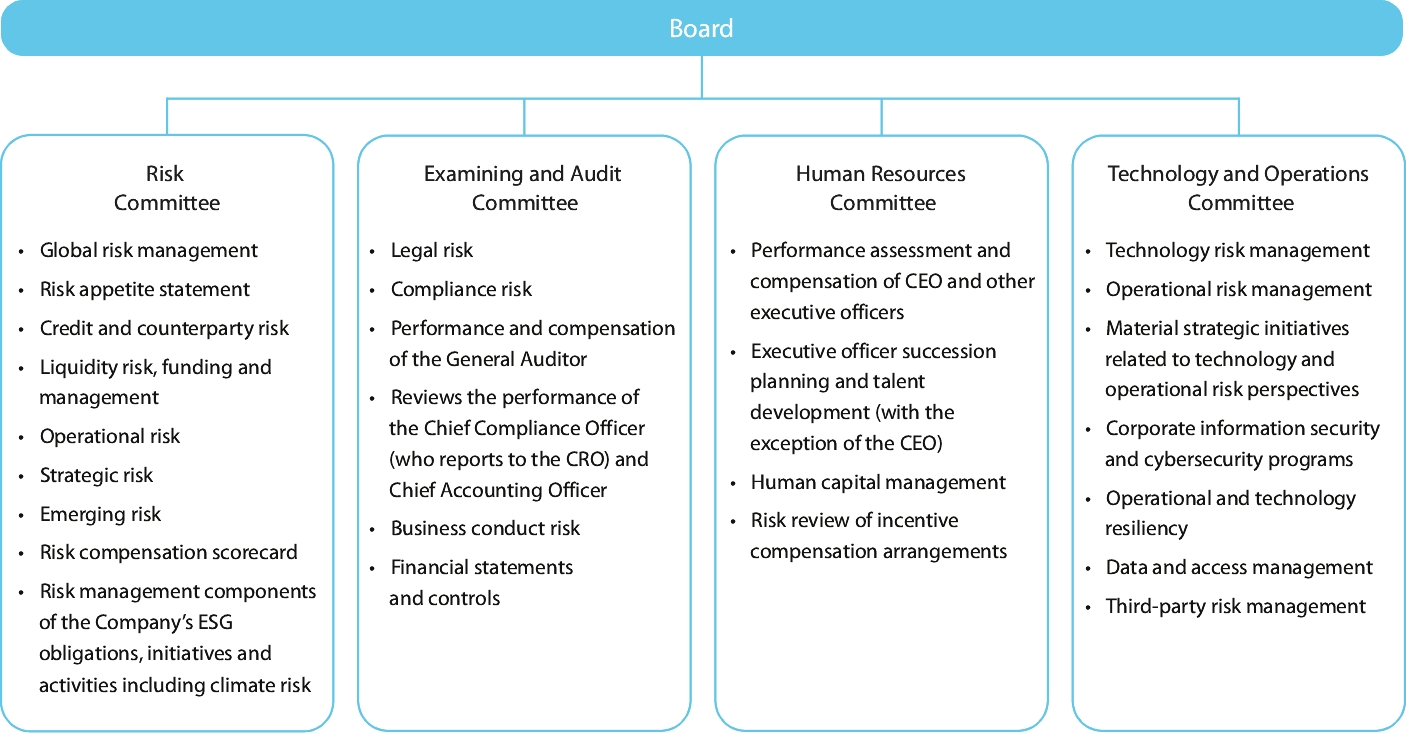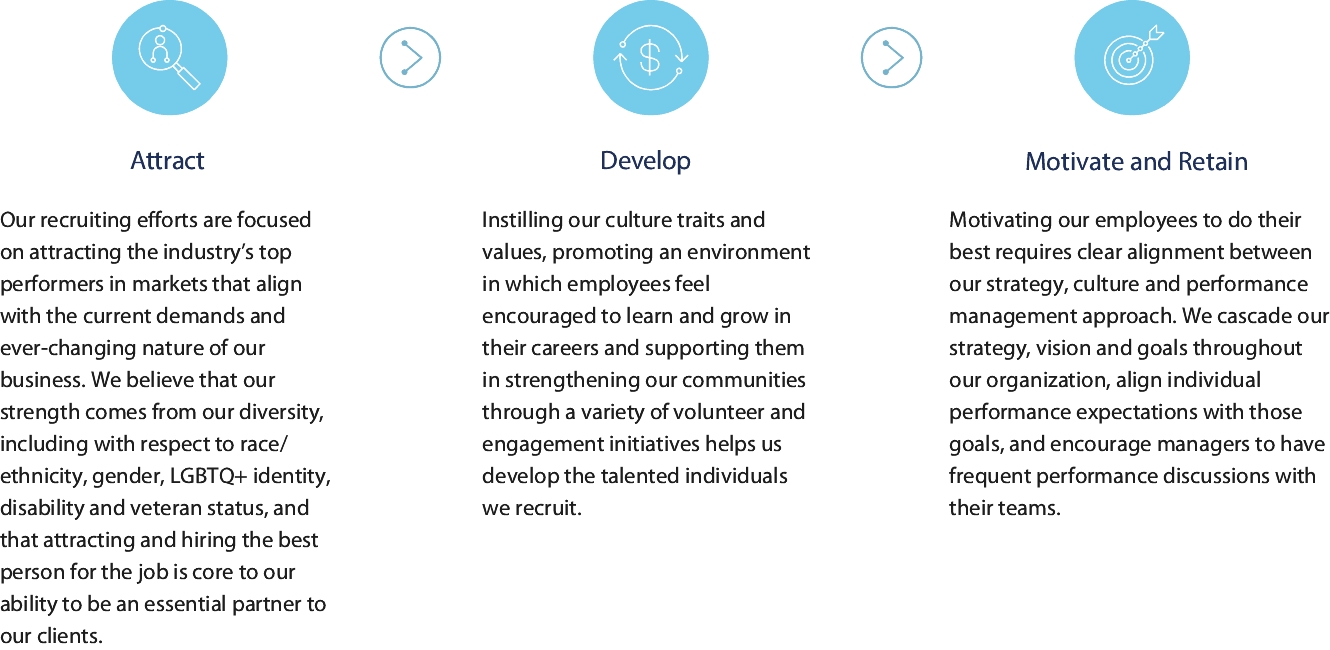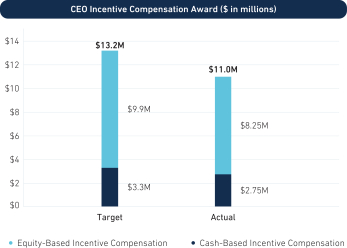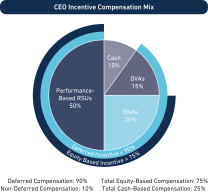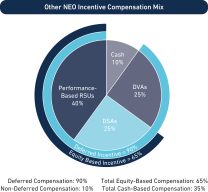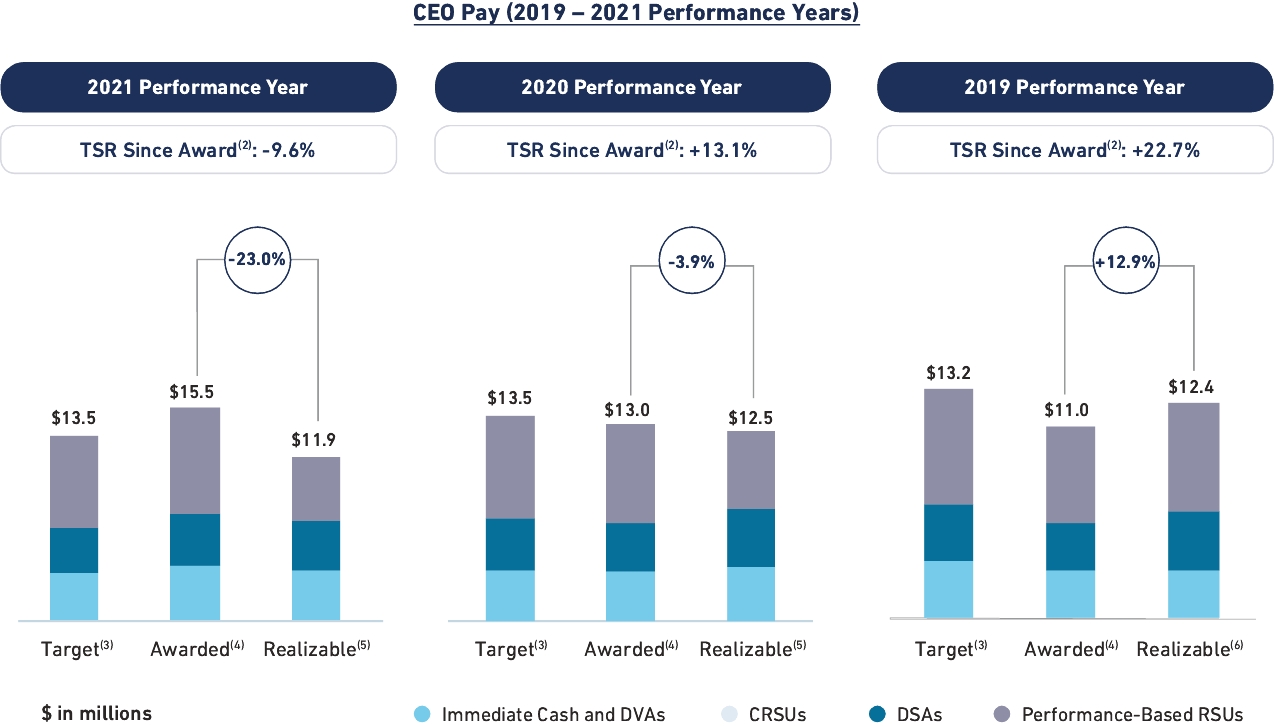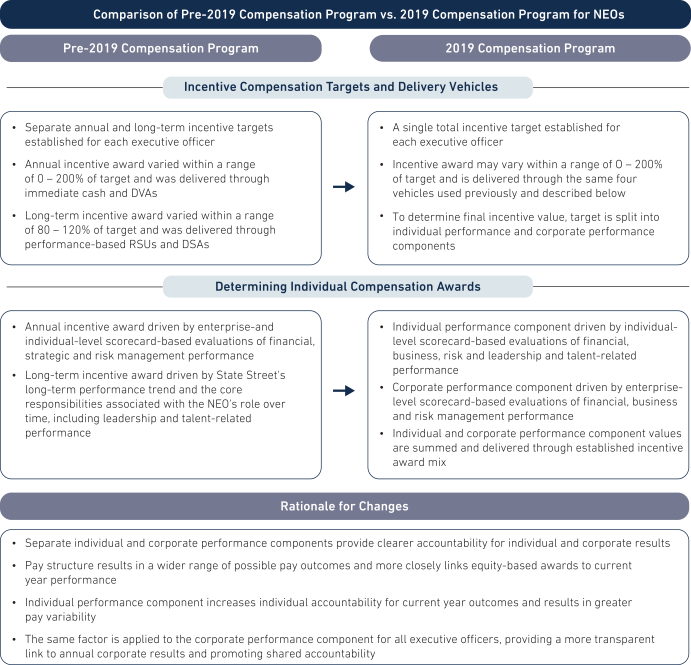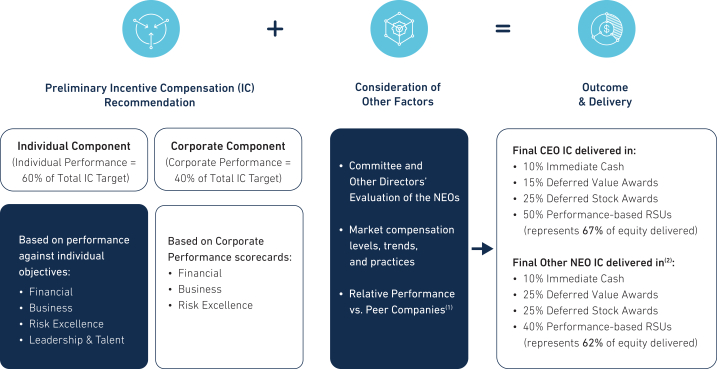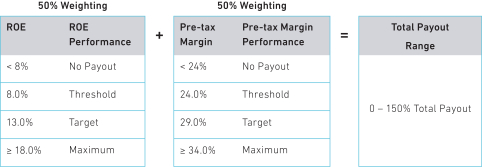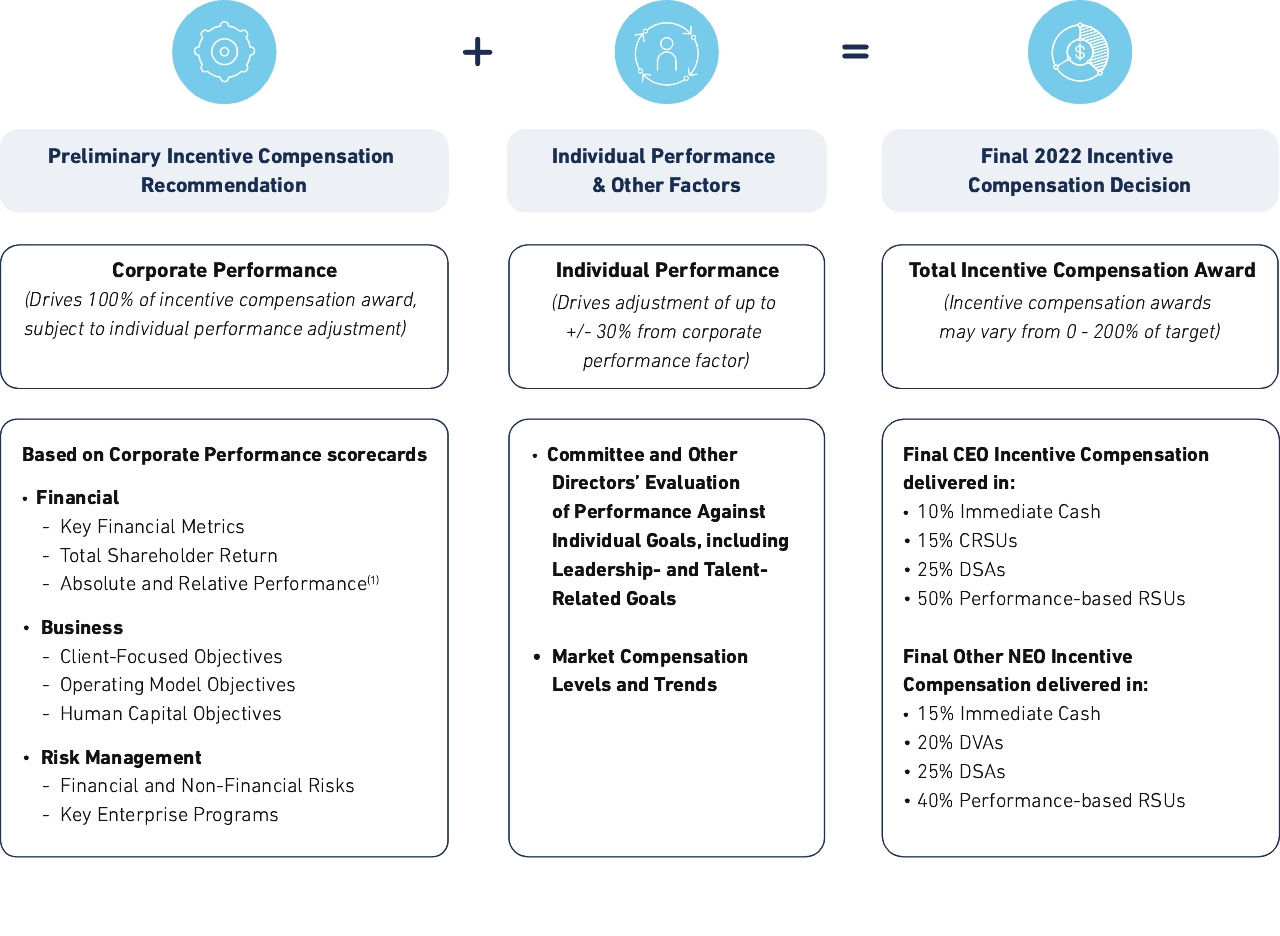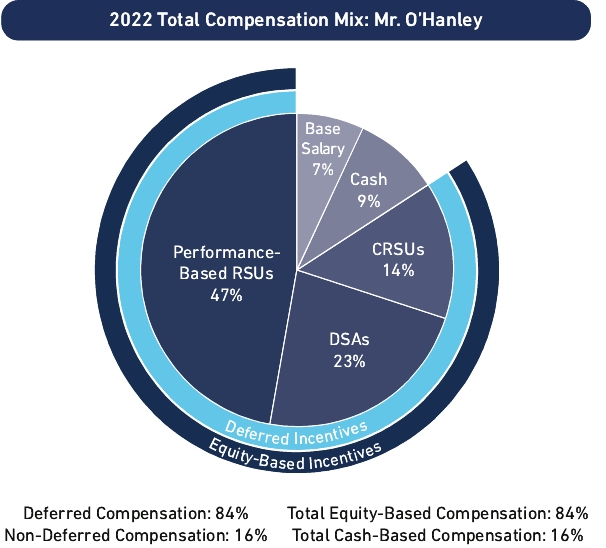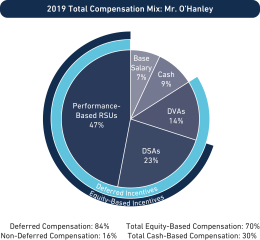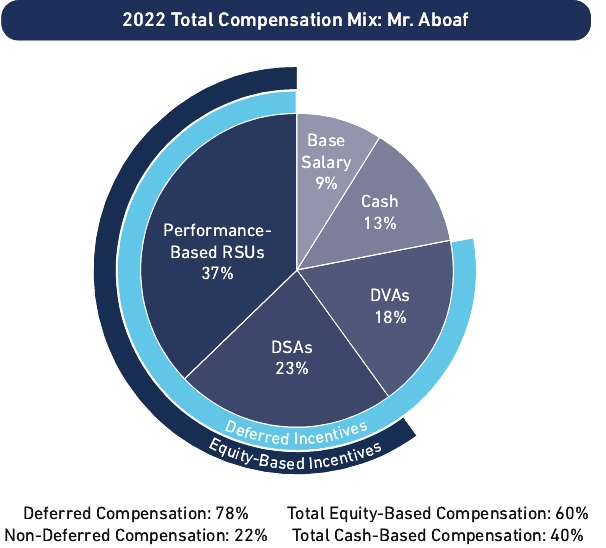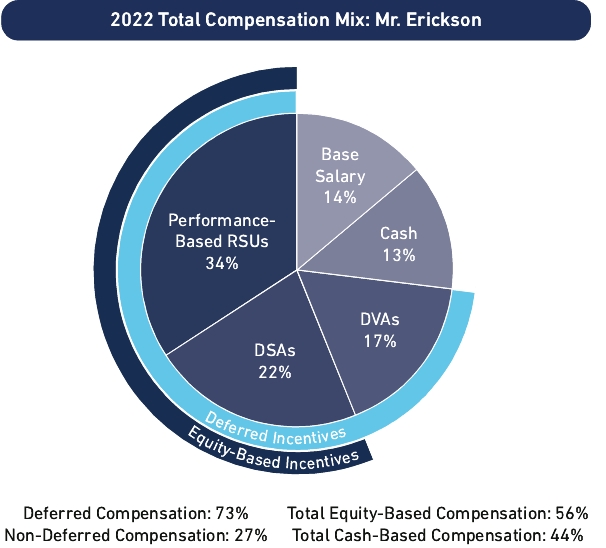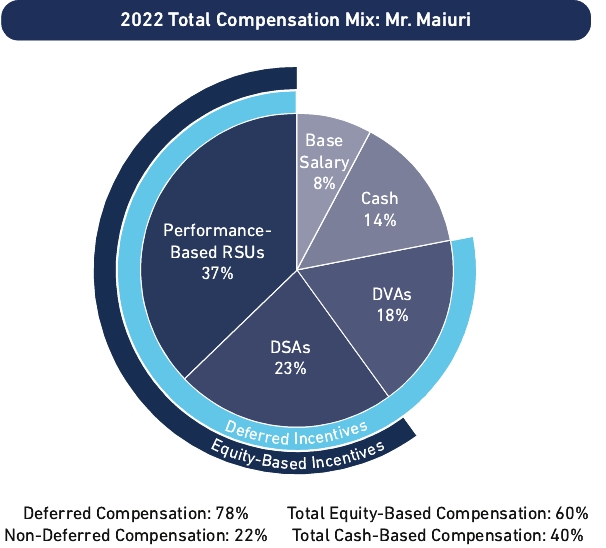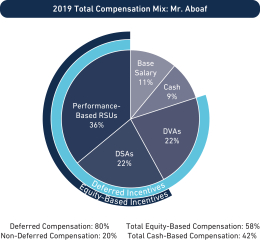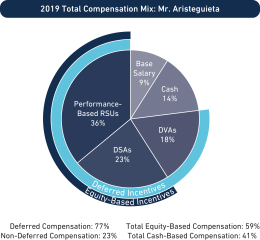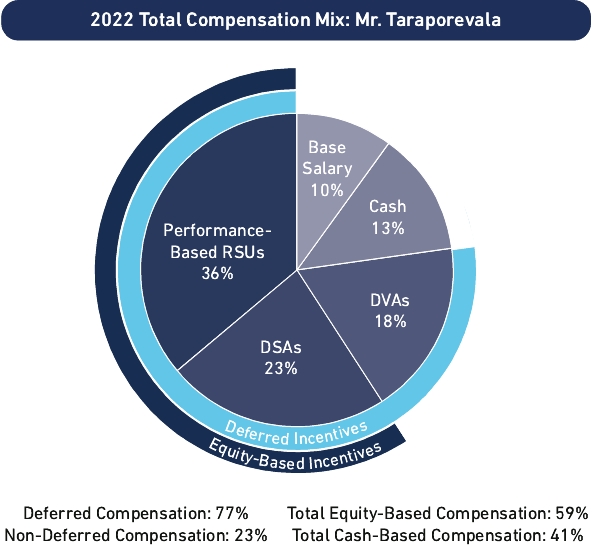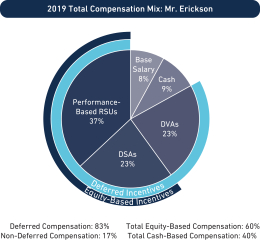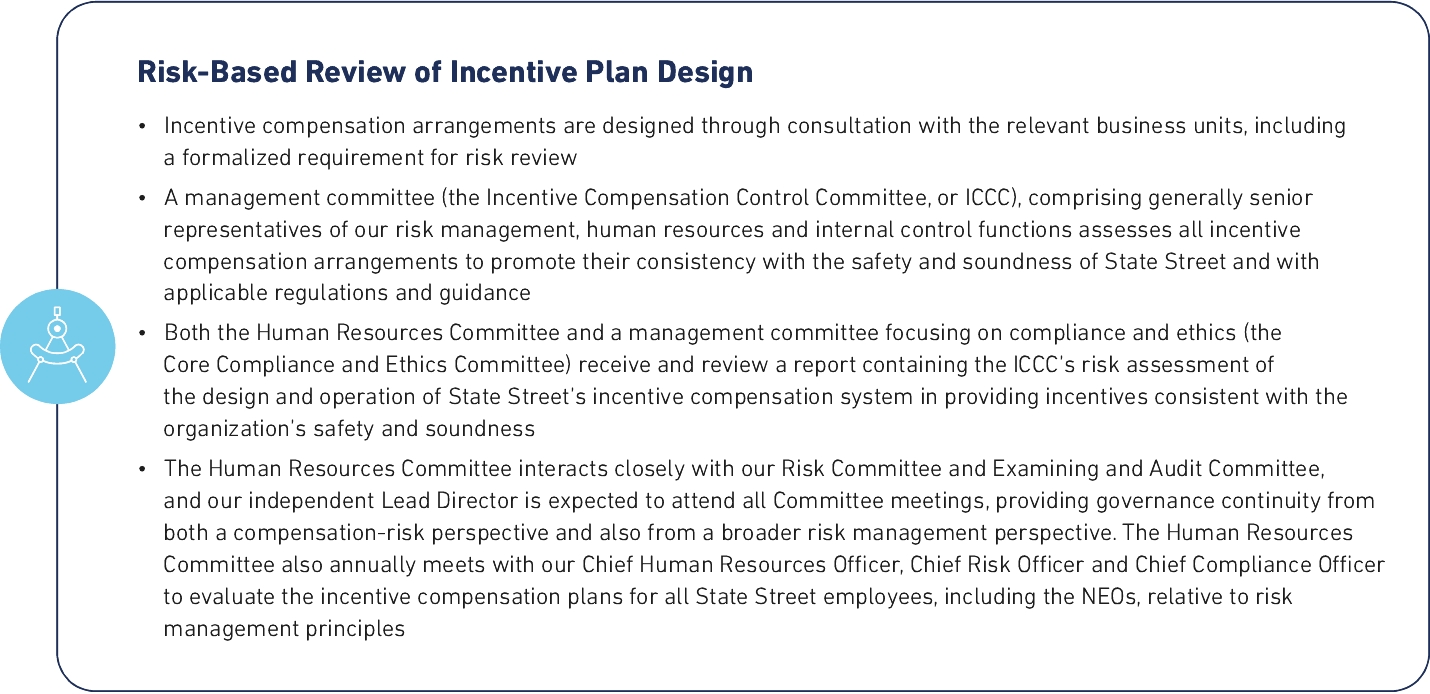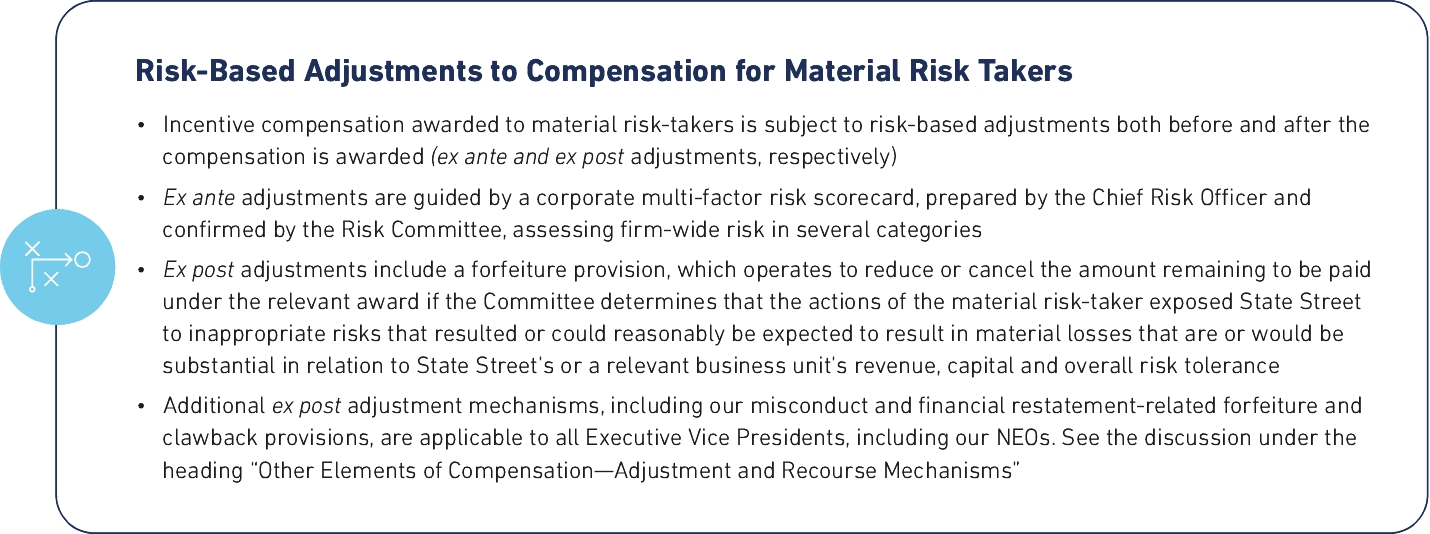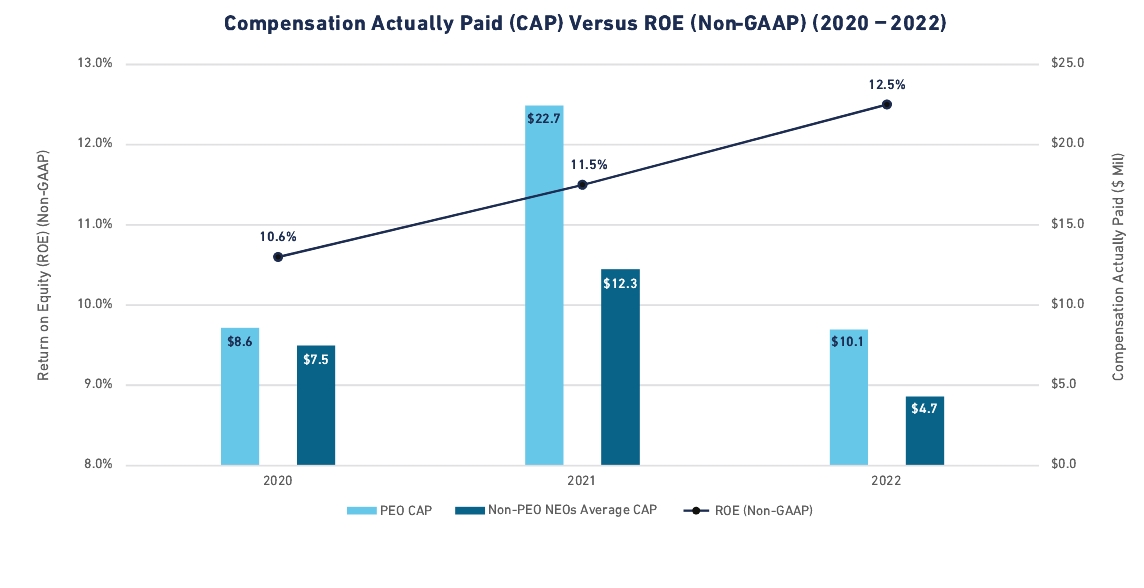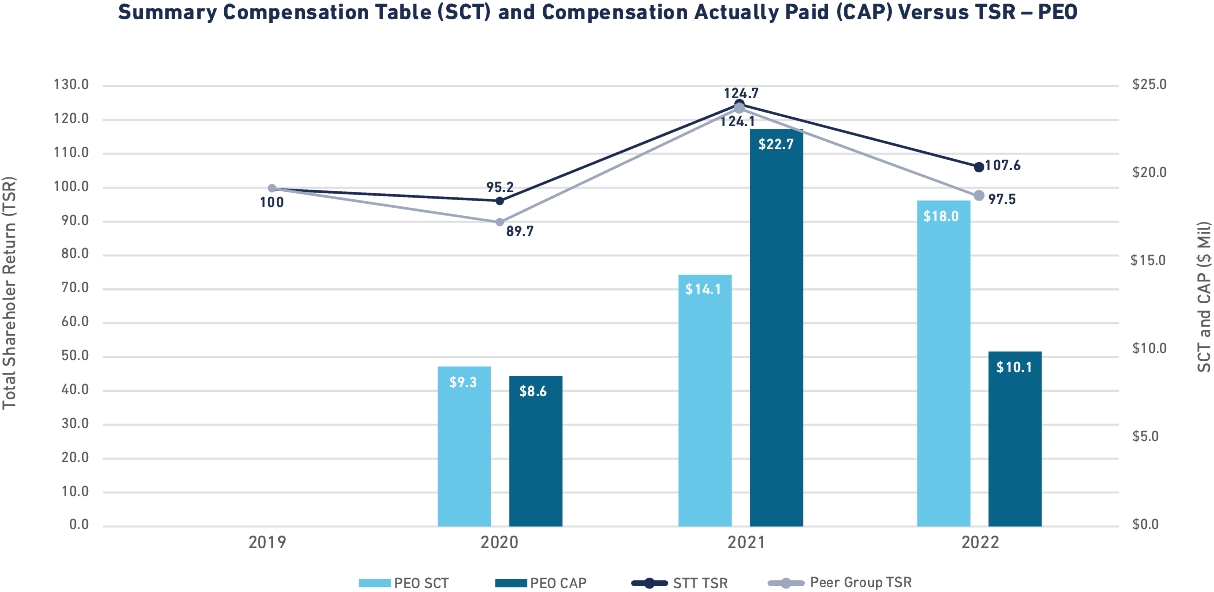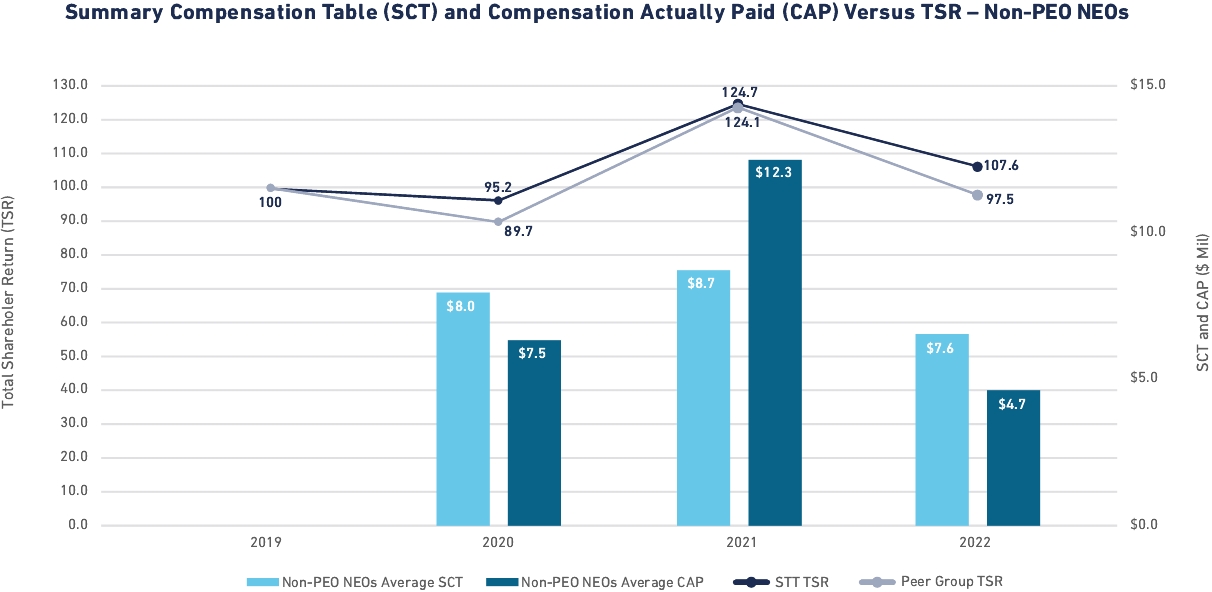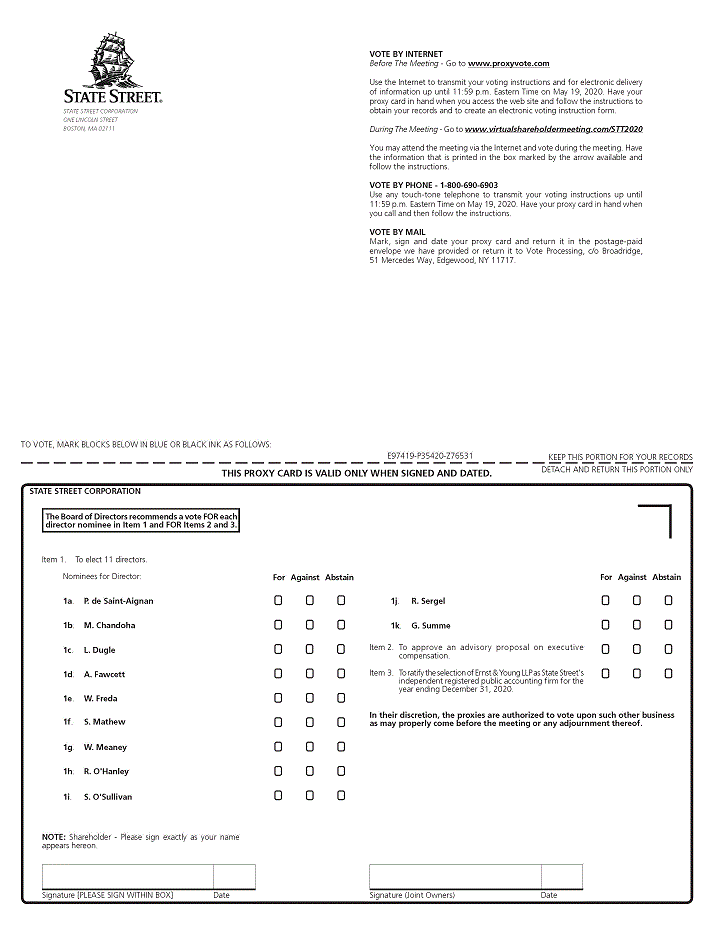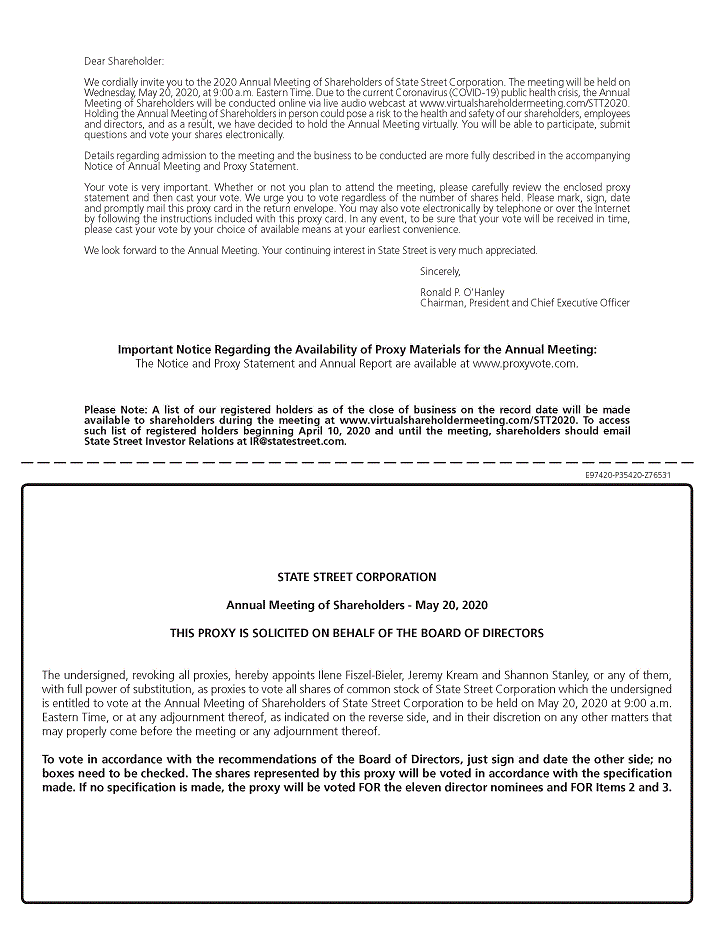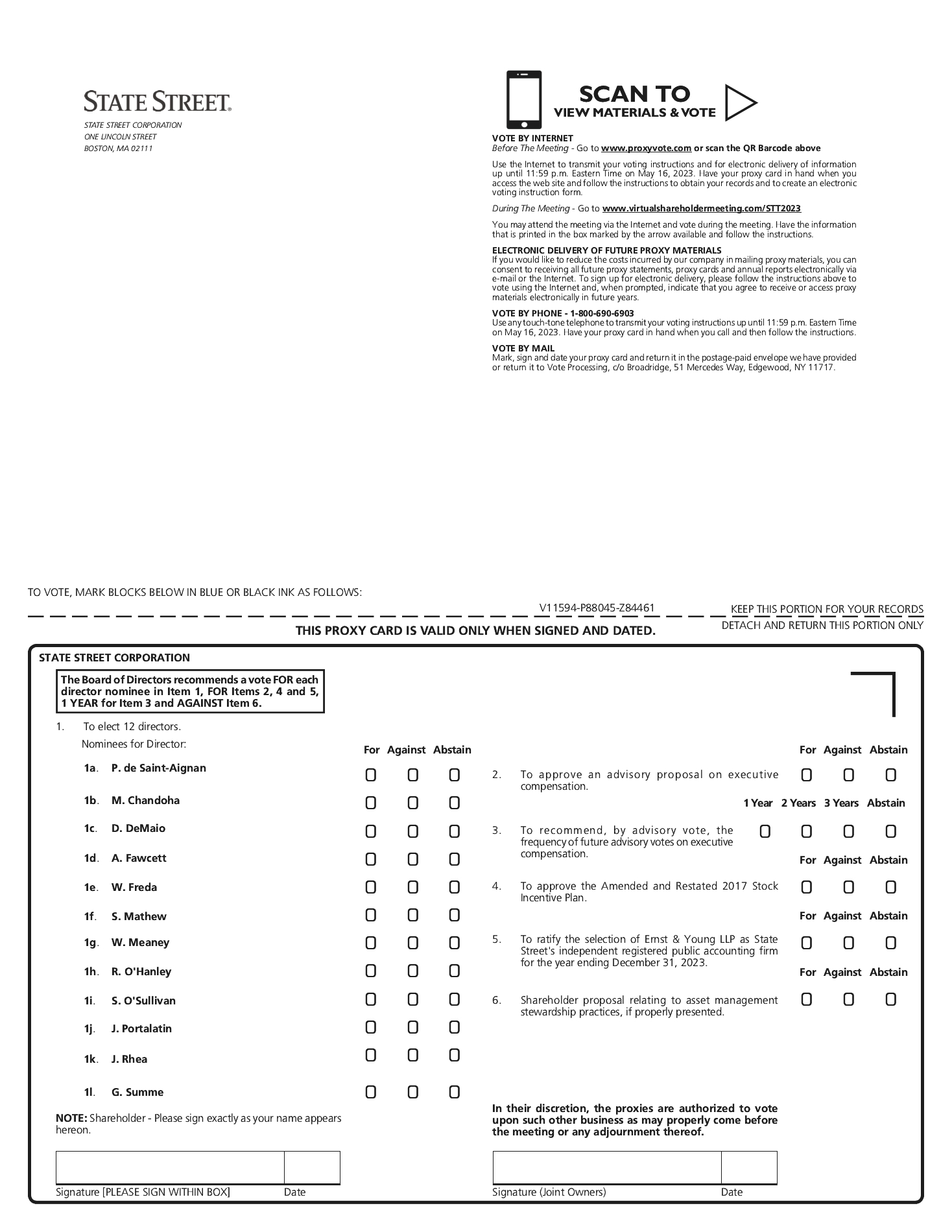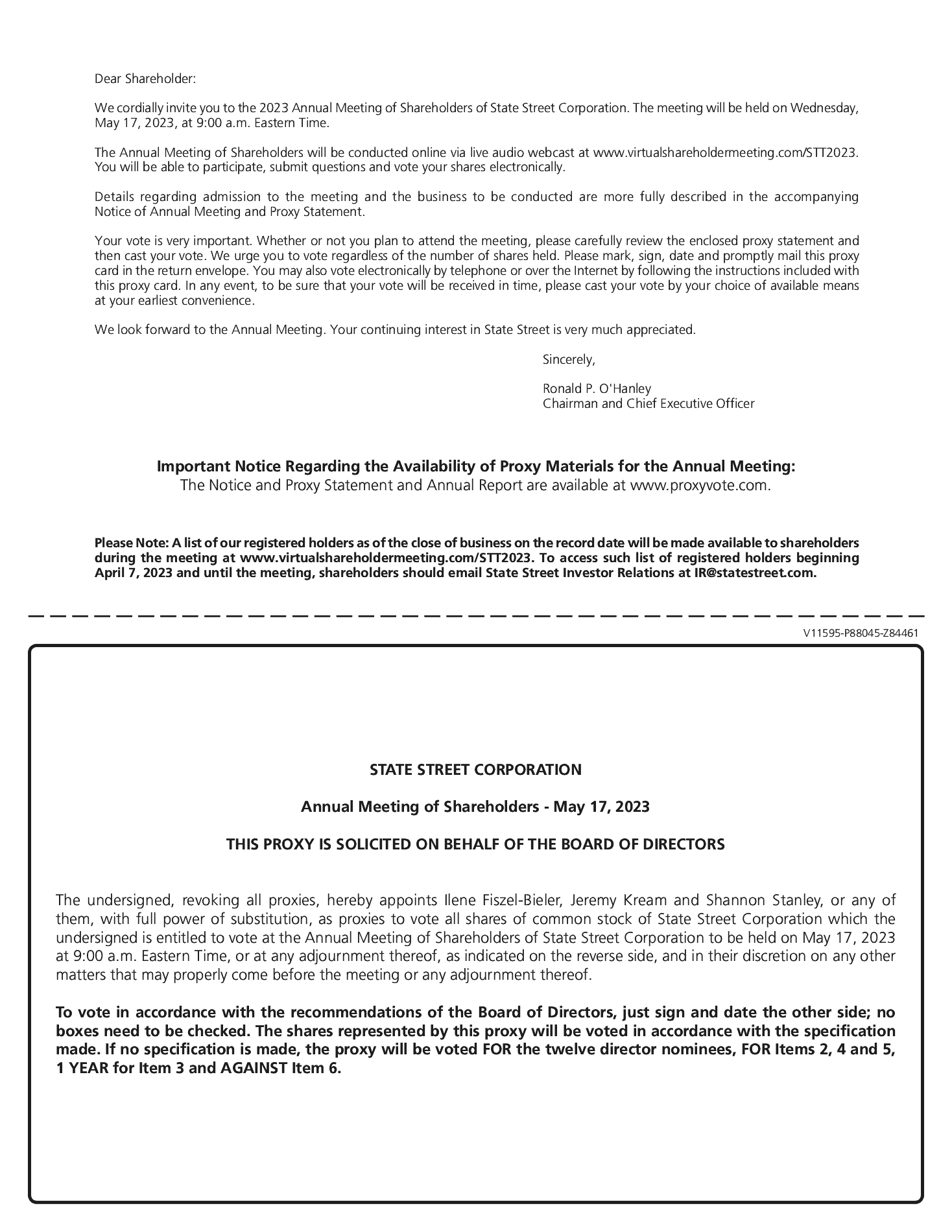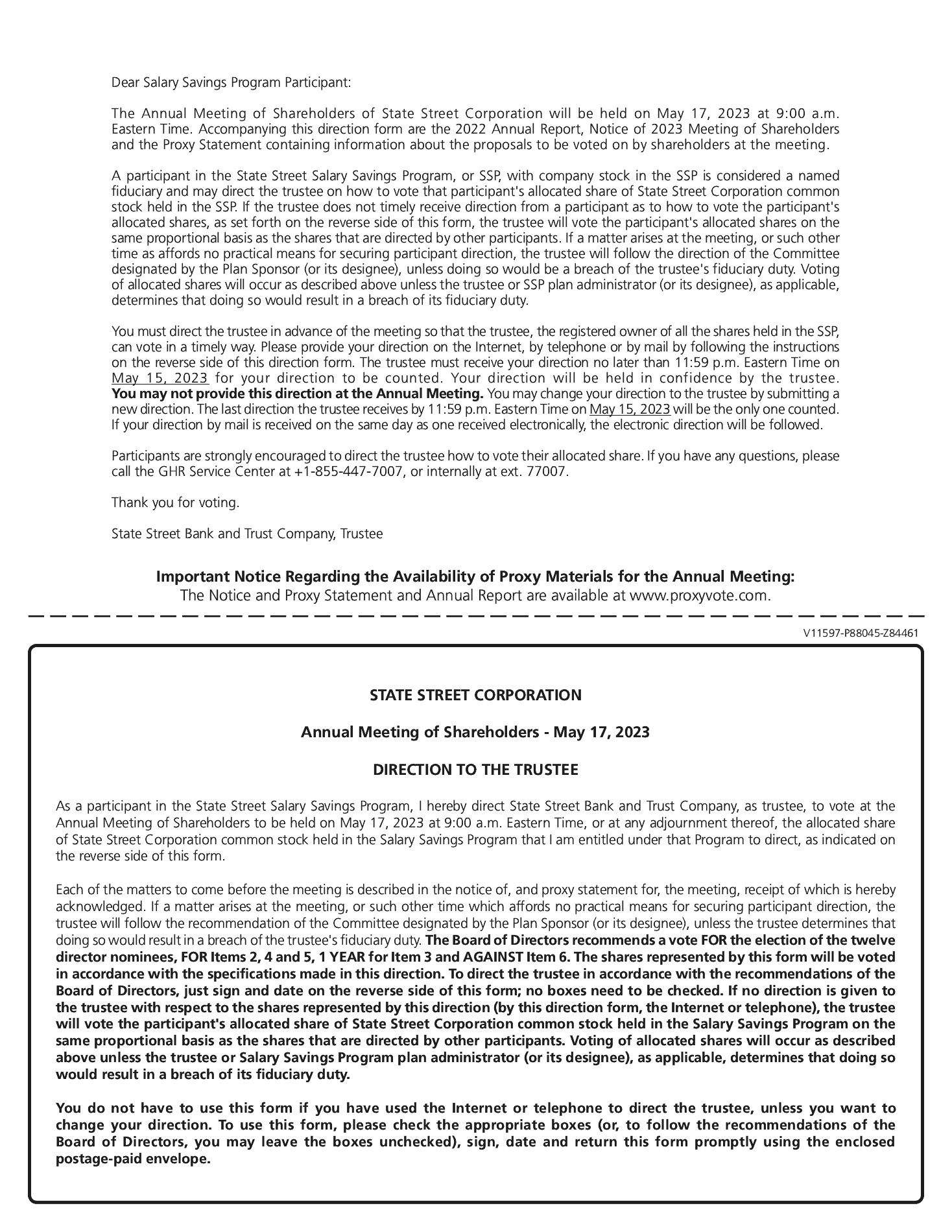TABLE OF CONTENTS
Corporate Governance at State Street
We have a Standard of Conduct for Directors, which together with the Standard of Conduct for Employees, promotes ethical conduct and the avoidance of conflicts of interest in conducting our business. We also have a Code of Ethics for Senior Financial Officers (including the Chief Executive Officer), as required by the Sarbanes-Oxley Act and SEC rules. Each of these documents is available under the “Corporate Governance” section in the
“For Our Investors” section“Investors” portion of our website at
www.statestreet.com. Only our Board may grant a waiver for directors, senior financial officers or executive officers from a provision of the Standard of Conduct for Directors, the Standard of Conduct for Employees or the Code of Ethics for Senior Financial Officers, and any waivers will be posted under the “Corporate Governance” section in the “For Our Investors” section“Investors” portion of our website atwww.statestreet.com.
Board Composition
In connection
The Nominating and Corporate Governance Committee, with
input from the Board, is responsible for nominating directors for election each year and evaluating the need for new director candidates as
appropriate, including skill sets, diversity, specific business backgroundappropriate. This assessment includes an evaluation of each director nominee’s skills and
global or international experience
in the
Nominating and Corporate Governance Committee, with input fromcontext of the
entireneeds of the Board, and
management, focuses on the Board’s capabilitiesindependence, as well as consideration of diverse perspectives and
functioningexperiences, and other characteristics, such as
a whole.Director Nominee Characteristicsrace/ethnicity, gender identity, sexual orientation, disability, military status and Qualifications
The Board expects all directors and director nominees to possess the following attributes or characteristics:
nationality.Director Nominee Characteristics and Qualifications |
The Board expects all director nominees to possess the following attributes or characteristics: |
• | • | | unquestionable business ethics, irrefutable reputation and superior moral and ethical standards |
• | |
| | • | | informed and independent judgment with a balanced perspective, financial literacy, mature confidence, high performance standards and incisiveness |
• | |
| | • | | ability and commitment to attend Board and committee meetings and to invest sufficient time and energy in monitoring management’s conduct of the business and compliance with State Street’s operating and administrative procedures |
• | |
| | • | | a global vision of business with the ability and willingness to work closely with the other Board members |
Taken as a whole, the Board expects one or more of its members to have the following skill sets, specific business background and global or international experience: |
• | |
Taken as a whole, the Board expects one or more of its members to have the following skill sets, specific business background and global or international experience:
| | • | | experience in the financial services industry |
• | |
�� | • | | experience as a senior officer of a well-respected public company |
• | |
| | • | | experience as a senior business leader of an organization active in our key international growth markets |
• | |
| | • | | experience in key disciplines of significant importance to State Street’s overall operations |
• | |
| | • | | qualification as an audit committee financial expert |
• | |
| | • | | qualification as a risk management expert |
|
4 2023 Notice of Meeting and Proxy Statement / State Street Corporation
TABLE OF CONTENTS
| | | | |
| | State Street Corporation
| | 3 |
Corporate Governance at State Street
| | |
Corporate Governance(cont.)
| | 2020 NOTICE OF MEETING AND PROXY STATEMENT
|
AnnualBoard, Committee and Director
EvaluationsTheSelf-Assessment
As part of the annual evaluation on the composition of the Board, the Nominating and Corporate Governance Committee annually assessesfacilitates an assessment of the performance and effectiveness of the Board and each principal standing committee. This evaluation also includes an annual assessment of each director’s performance and contributions to the overall effectiveness of the Board. Board and its committees.

The purpose of the Board and committee assessment is multi-faceted with the primary goal to evaluate the effectiveness, function, strength and productivity of the Board and its committees, and also to highlight potential areas for change and improvement. The Nominating and Corporate Governance Committee discussesalso leverages this process to guide Board refreshment, committee composition and succession planning efforts, as well as to evaluate whether the key skills and qualifications of members of the Board are aligned with State Street strategy and determining the nominees to stand for annual shareholder election.
In 2021, the Nominating and Corporate Governance Committee and the Board engaged a third-party advisory firm to assist with strengthening the self-assessment process and to collect valuable insight and feedback from the directors. In 2022, the Board and the Nominating and Corporate Governance Committee again leveraged the third-party advisory firm to aid the self-assessment process to provide consistency in reporting, track progress over time and evaluate feedback on a comparative basis. The self-assessment procedure illustrated below and performed for 2022 was developed with guidance from the advisory firm.
2023 Notice of Meeting and Proxy Statement / State Street Corporation 5
TABLE OF CONTENTS
Corporate Governance at State Street
Assessment Themes and Development Plans
As part of the Board and committee self-assessment process, the Board met with the third-party advisory firm and discussed the themes and overall findings, including the strengths and areas of potential improvement of the Board and its various committees. Further, the Nominating and Corporate Governance Committee reviewed progress made against the action plans developed in the prior year, and considered further enhancements informed by the director feedback.
As part of director development, the Lead Director met with each director
to provide individual feedback, insights on strengths and
usingdevelopment opportunities. The Lead Director also used this opportunity to solicit individualized information from each director about the
evaluation criteria illustrated below measures each director’s performance.effectiveness of the Board and its committees. Based on the results of the
evaluation,2022 assessment process, the Board believes that each of the director nominees
serving at the time has substantial achievement in
his or hertheir personal and professional pursuits and has talents, experience,
judgementjudgment and integrity that will contribute to the best interests of State Street and to long-term shareholder value. The nominees as a group possess the skill sets, specific business background and global or international experience that the Board desires. The director nominee biographies set forth in this proxy statement under the heading “Item 1—Election of Directors” indicate each nominee’s qualifications, skills, experience and attributes that led the Board to conclude
he or shethey should
continue to serve as a director of State Street.
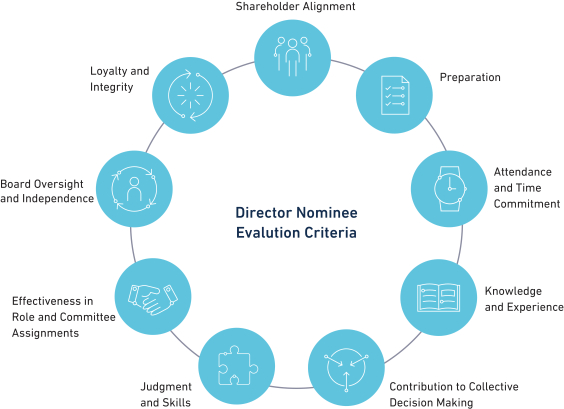
Annual Board and Committee Self-Evaluation
In addition, the Board and each Board committee conducts an annual self-evaluation of its performance and effectiveness. Directors complete a questionnaire evaluating the Board and each committee on which they serve, specifically focusing on areas of potential improvement. The overall performance of the Board—including its contributions to State Street—and a compilation of director responses is reviewed and discussed by the Nominating and Corporate Governance Committee and by the full Board. Similarly, the performance of each committee, along with specific committee member responses, is reviewed and discussed by the respective committee. The Nominating and Corporate Governance Committee further assesses whether each of the Examining and Audit Committee, Human Resources Committee, Nominating and Corporate Governance Committee, Risk Committee and Technology and Operations Committee has a functioning self-evaluation process and reports its findings to the Board. The Nominating and Corporate Governance Committee concluded, that for 2019, each of the respective committees had a functioning self-evaluation process.
| | | | |
| | State Street Corporation
| | 4 |
| | |
Corporate Governance(cont.)
| | 2020 NOTICE OF MEETING AND PROXY STATEMENT
|
Director Identification and Selection Process
The
In connection with its annual Board regularlyand committee assessment, the Board reviews its composition and size to evaluate its overall effectiveness and alignment with Company strategy. As part of this review, the Nominating and Corporate Governance Committee, in conjunction with the Board, establishes the desired criteria, skills and areas of expertise needed to continue to support the Board in advancing the Company’sState Street’s businesses and strategy. Once the desired characteristics are established, the Committee reviews each director candidate. Illustrated below is an overview of the process used to identify the desired attributes and to select new candidates for the Board.
6 2023 Notice of Meeting and Proxy Statement / State Street Corporation
TABLE OF CONTENTS
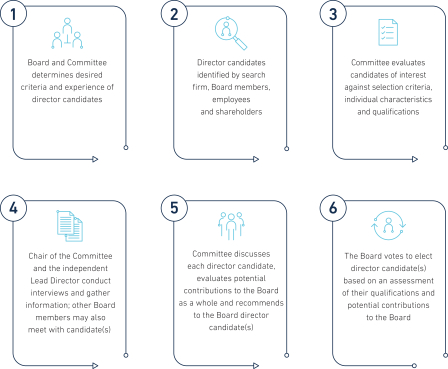
Ms. Marie Chandoha is a first-time nominee for election as a director by shareholders
Corporate Governance at the 2020 annual meeting. Ms. Chandoha was first identified by a third-party search firm that was retained to identify potential director candidates. At the request of theState Street
The Nominating and Corporate Governance Committee
the search firm first discussedseeks to identify individuals qualified to become directors, consistent with the
members of the Committee the priority characteristics of a new director candidate, in light of the preferred individual and Board qualities discussed above. The search firm provided the Committee a list of candidates who were interested in State Street and who met the selection criteria, experience and characteristics, and the Chairman of the Board, Chair of the Nominating and Corporate Governance Committee and select members of the Committee and Board personally conducted interviews. The Board is nominating Ms. Chandoha as she meets several of the criteria identified
by the Board for new directors, including Ms. Chanodha’s extensive leadership experience in the financial services industry and track record of transforming businesses. Both the Nominating and Corporate Governance Committee and the Board of Directors believes that Ms. Chandoha has the background and requisite experience to make significant contributions on many levels to State Street through her continued service as a director. Ms. Chandoha was deemed independent by the Board under the Corporate Governance Guidelines.criteria. In carrying out its responsibility to identify the best qualifiedbest-qualified candidates for directors, the Nominating and Corporate Governance Committee will consider proposals for nominees from a number of sources, including recommendations from shareholders submitted upon written notice to the to:
Chair of the Nominating and Corporate Governance Committee
c/o the Office of the Secretary of State Street Corporation,
One Lincoln Street, Boston, Massachusetts 02111
(facsimile number(617) 664-8209). The Committee seeks to identify individuals qualified to become directors, consistent with the identified criteria.
(or, after May 6, 2023, One Congress Street, Boston, Massachusetts 02114)
By following the procedures set forth under “General Information About the Annual Meeting—Proposals and Nominations by Shareholders,” shareholders also have the right under ourby-laws to directly nominate director candidates and, in certain circumstances, to have their nominees included in State Street’s proxy statement.
2023 Notice of Meeting and Proxy Statement / State Street Corporation 7
TABLE OF CONTENTS
| | | | |
| | State Street Corporation
| | 5 |
Corporate Governance at State Street
| | |
Corporate Governance(cont.)
| | 2020 NOTICE OF MEETING AND PROXY STATEMENT
|
Director Nominee Qualifications, Diversity and Skills
We believe that our Board of Directors should have a variety of qualifications, skill sets and experience that, when taken as a whole, best serve the Company and our shareholders. We recognize the importance of diversity with regard to the composition of the Board and strive to have a Board that provides diversity of thought and a broad range of perspectives. In an effort to achieve these objectives, the Nominating and Corporate Governance Committee and the Board consider a wide range of attributes when determining and assessing director nominees and new candidates in the context and needs of the Board, including personal and professional backgrounds, gender, race, national originindependence and tenure of Board service.service, and other demographics such as race and ethnicity, gender identity, sexual orientation, disability, military service and nationality. The Nominating and Corporate Governance Committee is committed to considering diversityincluding qualified diverse candidates in itsthe pool from which director candidate recommendations.candidates are chosen. The Committee does not assign specific weight to the various factors it considers and no particular criterion is a prerequisite for nomination. As summarized below, each of our directorsdirector nominees brings to the Board a variety of qualifications and skills and, collectively, these qualifications form a depth of broad and diverse experiences that help the Board effectively oversee our activities and operations.

8 2023 Notice of Meeting and Proxy Statement / State Street Corporation
TABLE OF CONTENTS
Corporate Governance at State Street
Director Nominee Skills, Qualifications and Demographics
Director Nominee Composition Highlights
2023 Notice of Meeting and Proxy Statement / State Street Corporation 9
TABLE OF CONTENTS
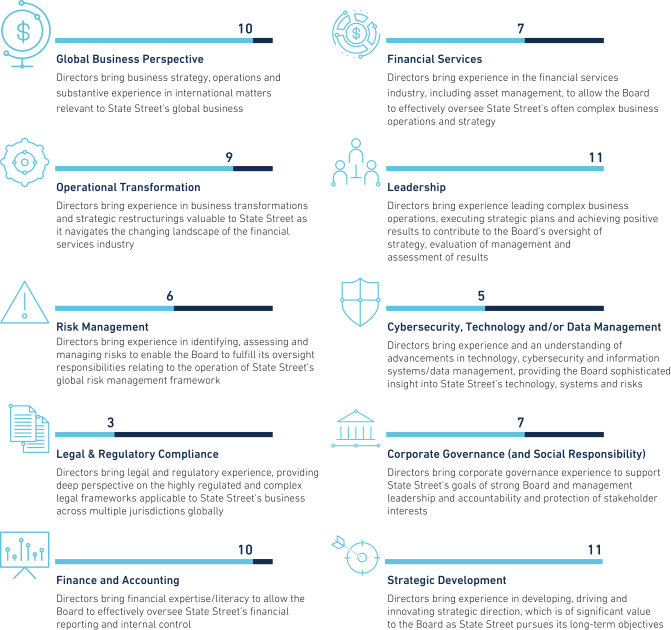
| | | | |
| | State Street Corporation
| | 6 |
Corporate Governance at State Street
| | |
Corporate Governance(cont.)
| | 2020 NOTICE OF MEETING AND PROXY STATEMENT
|

Board Leadership Structure
Leadership Transition
During the past year, the Company completed its leadership transition. On January 1, 2019, Ronald P. O’Hanley assumed the role of Chief Executive Officer and effective January 1, 2020, he was appointed as Chairman of the Board. In addition to serving as Chairman and Chief Executive Officer, Mr. O’Hanley has served as President since November 2017.
Role in Risk Oversight
State Street’s leadership structure includes an independent Lead Director of the Board. This position is currently held by
Dame Amelia C. Fawcett.
Dame AmeliaShe was elected
to her fourth one-year term as Lead Director in May
2019 for a term that expires in May 2020.2022.
As Chairman, Mr. O’Hanley presides at all meetings of the Board of Directors during which he is present and
he works with the independent Lead Director to establish the agendas for these meetings and
the matters on which the Board will vote.
Role of the Independent Lead Director
Role of the Independent Lead Director |
• | • | | Elected annually by the independent directors to serve aone-year term |
• | |
| | • | | Expected to participate in, and attend, meetings of all of the Board’s committees, providing valuable committee membership overlap to enable optimal agenda coordination, insight and consistency across all committees and helping to strengthen risk oversight |
• | |
| | • | | Presides at all meetings of the Board during which the Chairman is not present, including all executive sessions of independent directors occurring at every regularly scheduled Board meeting |
• | |
| | • | | Serves as a liaison between the Chairman and the independent directors |
• | |
| | • | | Authorized to call additional meetings of the independent directors |
• | | | Communicates frequently with the Chairman to provide feedback and implement the decisions and recommendations of the independent directors |
• | • | | Conducts an annual process for reviewing the Chief Executive Officer’s performance and reports the results of the process to the other independent directors |
• | |
| | • | | Communicates
Meets at least annually with the Chairman to provide feedback and implement the decisions and recommendationssuch members of the independent directorssenior leadership team as the Lead Director determines from time to time |
• | |
| | • | | Represents the Board in discussions with stakeholders and communicates with regulators |
• | |
| | • | | Approves, in consultation with the Chairman, the agendas for Board meetings, and information sent to the Board and the matters voted on by the full Board |
|
| | | | |
| | State Street Corporation
| | 7 |
| | |
Corporate Governance(cont.)
| | 2020 NOTICE OF MEETING AND PROXY STATEMENT
|
Board Leadership Review Process
The Nominating and Corporate Governance Committee coordinates the annual independent Lead Director nomination and election process. In addition, the Board of Directors reviews
the Boardits leadership structure at least annually to assess and determine
the appropriate structure for the Company.whether it remains appropriate. The Board values the flexibility to
permit frequent review and
determination ofdetermine the appropriate leadership structure based on
theState Street’s opportunities and circumstances
of the Company at any given time.
After the independent directors’
2022 review and assessment, the Board of Directors
believescontinues to believe that Mr. O’Hanley’s role as
Chairman, Chairman—together with a strong independent Lead Director,
is currentlyconsistent with Dame Amelia’s performance in the role—continues to be the most effective leadership structure for State Street and
is in the best interests of the Board, State Street and its
shareholders.shareholders at this time.
Among the factors considered by the Board in determining that the current leadership structure
isremains the most appropriate are:
as our Chief Executive Officer, and with his experience in various leadership roles at State Street, Mr. O’Hanley has extensive knowledge of our business and strategy and is well positioned to work with the independent Lead Director to focus our Board’s agenda on the key issues facing State Street
oversight of State Street is the responsibility of our Board as a whole, which maintains a majority of independent directors (10(11 out of 1112 director nominees), and this responsibility can be properly discharged with a strong, active and engaged independent Lead Director
the Chairman and independent Lead Director work together to play a strong and active role in the oversight of State Street’s business strategy and operational management
10 2023 Notice of Meeting and Proxy Statement / State Street Corporation
TABLE OF CONTENTS
Corporate Governance at State Street
Board Risk Oversight
In the normal course of our business activities, State Street is exposed to a variety of risks, some that are inherent in the financial services industry and others that are more specific to our business activities. The identification, assessment, monitoring, mitigation and reporting of risks are essential to State Street’s financial performance and successful management of our businesses. Risk management, including Board and senior management oversight and a system of policies, procedures, limits, risk measurement and monitoring and internal controls, allows for an assessment of risks for evaluating opportunities for the prudent use of capital that appropriately balances risk and return. Our established risk appetite framework outlines the quantitative limits and qualitative goals that define the level and type of risk we are willing to undertake in the course of executing our business strategy, and also serves as a guide in setting risk limits across our business units. The framework is established by Enterprise Risk Management (ERM), a management-level corporate risk oversight group, in conjunction with the Management Risk and Capital Committee, our senior management decision-making body for risk and capital issues, and the Risk Committee of the Board. The Board and the Risk Committee formally review and approve our risk appetite statement annually, or more frequently in response to shifts in endogenous or exogenous risk conditions.
ERM provides risk oversight, support and coordination to allow for the consistent identification, measurement and management of risks across business units separate from the business units' activities, and is responsible for the formulation and maintenance of corporate-wide risk management policies and guidelines. In addition, ERM establishes and reviews limits and, in collaboration with business unit management, monitors key risks. Ultimately, ERM works to validate that risk-taking occurs within the risk appetite statement approved by the Board and conforms to associated risk policies, limits and guidelines.
Four of the Board's committees (shown below) assist the Board in discharging its responsibilities with respect to risk management. State Street, as a large bank holding company, is required by regulations of the Board of Governors of the Federal Reserve System to have a Risk Committee. The Risk Committee is responsible for oversight related to the operation of our global risk management framework, including policies and procedures establishing risk management governance and processes and risk control infrastructure. It is responsible for reviewing and discussing with management our assessment and management of all risks applicable to our operations, including among other matters, credit, market, interest rate, liquidity, operational, regulatory, technology, business, compliance and reputation risks, and related policies. The Risk Committee also receives quarterly updates from other Board committees regarding risk-related matters reviewed by other Board-level committees.
The structure of the Risk Committee assists the Board in administering its oversight of risk management throughout our company. The Risk Committee includes at least one member who has experience in identifying, assessing and managing risk exposures of a large, complex financial firm and all members of the Risk Committee have an understanding of risk management principles and practices relevant to the Company. In addition, the Lead Director participates in meetings of the Risk Committee and the Chairman of the Board is a current member of the Risk Committee. For more details regarding the Risk Committee and our other Board committees, please refer to “Committees of the Board of Directors.”
The Chief Risk Officer (CRO) is responsible for our risk management globally, leads ERM and has a dual reporting line to our CEO and the Risk Committee. The Chief Compliance Officer reports to the Chief Risk Officer. The Company’s risk management is further discussed in Part II, Item 7 of the Company’s Annual Report on Form 10-K for the year ended December 31, 2022 (2022 Form 10-K).
2023 Notice of Meeting and Proxy Statement / State Street Corporation 11
TABLE OF CONTENTS
Corporate Governance at State Street
Communication with the Board of Directors
Shareholders and interested parties who wish to contact the Board of Directors or the Lead Director should address correspondence to the Lead Director in care of the Secretary. The Secretary will review and forward correspondence to the Lead Director or
the appropriate person or persons for response.
Lead Director of State Street Corporation
c/o Office of the Secretary
(or, after May 6, 2023, One Congress Street, Boston, Massachusetts 02114)
Alternatively, by email: corporatesecretary@statestreet.com
In addition, State Street has established a procedure for communicating directly with the Lead Director, by utilizing a third-party independent provider, regarding concerns about State Street or its conduct, including complaints about accounting, internal accounting controls or auditing matters. An interested party who wishes to contact the Lead Director may use any of the following methods, which are also described on State Street’s website at
www.statestreet.com:
| | | | | | | | | |
| | From within the United States
and Canada:
1-888-736-9833 (toll-free) | | | ATTN: State Street
5500 Meadows Road, Suite 500
Lake Oswego, OR 97035 USA | | | https://secure.ethicspoint.com/
domain/media/en/gui/55139/
index.html | |
For country-specific phone numbers, please visit
www.statestreet.com.The Lead Director may forward to the Examining and Audit Committee, or to another
Board committee, group or department, for appropriate review, any concerns the Lead Director receives. The Lead Director periodically reports to the independent directors as a group regarding concerns received.
| | | | |
| | State Street Corporation
| | 8 |
12 2023 Notice of Meeting and Proxy Statement / State Street Corporation
| | |
Corporate Governance(cont.)
| | 2020 NOTICE OF MEETING AND PROXY STATEMENT
|
TABLE OF CONTENTS
Corporate Governance at State Street
Meetings of the Board of Directors and Annual Meeting of Shareholders
During 2019,2022, the Board of Directors held 8eight meetings, and each of the incumbent directors attended, either in-person or virtually, at least 75 percent of the total of all meetings of the Board and committees for such period ason which the director served. served during his or her service as a director during the year.
Although State Street does not have a formal policy regarding attendance of directors at the annual meeting of shareholders, all directors are encouraged to attend. Each of the
12thirteen directors on the Board at the time of our
20192022 annual meeting of shareholders attended the
virtual meeting.
Committees of the Board of Directors The Board of Directors has the following
principal committees to assist it in carrying out its responsibilities, and each operates under a written charter, a copy of which is available under the “Corporate Governance” section in the
“For Our Investors” section“Investors” portion of our website at
www.statestreet.com. The charter for each committee, which establishes its roles and responsibilities and governs its procedures, is annually reviewed and approved by the Board.
Examining and Audit Committee
| | | |
• William C. Freda, Chair
• Marie A. ChandohaDonnaLee DeMaio
• Patrick de Saint-Aignan
• Lynn A. DugleSara Mathew
9 Meetings in 20192022 | | | Primary Responsibilities: | |
| | • Responsible for the appointment (including qualifications, performance, independence and periodic consideration of retaining a different firm), compensation, retention, evaluation and oversight of the work of State Street’s independent registered public accounting firm, including sole authority for the establishment of pre-approval policies and procedures for all audit engagements and any non-audit engagements | |
| | • Discusses with the independent auditor critical accounting policies and practices, alternative treatments of financial information, the effect of regulatory and accounting initiatives and other relevant matters | |
| | • Oversees the operation of our system of internal control covering the integrity of our consolidated financial statements and reports; compliance with laws, regulations and corporate policies; and the performance of corporate audit | |
| | • Reviews the effectiveness of State Street’s compliance program and conducts | |
| | • Conducts an annual performance evaluation of the General Auditor and reviews the performance of the Chief Compliance Officer and other senior members of management as appropriate | |
| | • Oversees the Company’s efforts to promote and advance a culture of compliance and ethical business practices | |
|
All members meet the independence requirements of the listing standards of the NYSE and the rules and regulations of the SEC and are considered audit committee financial experts (as defined by SEC rules).
| | • Oversees the compliance, culture and reporting components of State Street’s ESG obligations, initiatives and activities | | | |
| | All members meet the independence requirements of the listing standards of the NYSE and the rules and regulations of the SEC and are considered audit committee financial experts (as defined by SEC rules). | State Street Corporation
| | 9 |
2023 Notice of Meeting and Proxy Statement / State Street Corporation 13
TABLE OF CONTENTS
Corporate Governance at State Street
Executive Committee
| | | |
Corporate Governance(cont.)
| | 2020 NOTICE OF MEETING AND PROXY STATEMENT
|
Executive Committee
| | |
• Ronald P. O’Hanley, Chair
• Patrick de Saint-Aignan• Lynn A. Dugle
• Richard P. SergelSara Mathew
• GregoryWilliam L. Summe0Meaney
• Sean O’Sullivan
No Meetings in 20192022 | | | Primary Responsibilities: | |
| | • Committee members are the Chairs of each Committee, the independent Lead Director and Chairman of the Board and are authorized | |
| | • Authorized to exercise all the powers of the Board, except as otherwise limited by the laws of the Commonwealth of Massachusetts law or the Committee’s charter | |
| | • Reviews, approves and acts on matters on behalf of the Board at times when it is not practical to convene a meeting of the Board to address such matters | |
| | • DependingPeriodically reports to the Board depending on meeting activities, if any periodically reports to the Board | |
Human Resources Committee
| | | |
• Sara Mathew, Chair
• Amelia C. Fawcett
• William L. Meaney
• Julio A. Portalatin
• Richard P. Sergel Chair*• Kennett F. Burnes
• Amelia C. Fawcett
• William L. Meaney
10 Meetings in 2019*Sara Mathew, Chair-elect
(effective May 2020)
2022 | | | Primary Responsibilities: | |
| | • Oversees human capital management strategies, the operation of all compensation plans, policies and programs in which executive officers participate and certain other incentive, retirement, health and welfare and equity plans in which other employees participate | |
| | • Oversees the alignment of our incentive compensation arrangements with the safety and soundness of State Street, including the integration of risk management objectives and related policies, arrangements and control processes, consistent with applicable regulatory rules and guidance | |
| | • Acting together with the other independent directors, annually reviews and approves corporate goals and objectives relevant to the Chief Executive Officer’sCEO’s compensation; evaluates the Chief Executive Officer’sCEO’s performance; and reviews, determines and approves, in consultation with the other independent directors, the Chief Executive Officer’sCEO’s compensation | |
| | • Reviews, evaluates and approves the total compensation of all executive officers | |
| | • Reviews talent development and succession plans for executive officers (except for the CEO) | |
| | • Approves the terms and conditions of employment and any associated changes, thereto, including any restrictive provisions, severance arrangements and special arrangements or benefits, of any executive officer | |
| | • Adopts equity grant guidelines in connection with its overall responsibility for all equity plans and monitors stock ownership of executive officers who are members of the management Executive Committee, State Street's enterprise strategy-setting and decision-making body | |
| | • Appoints and oversees compensation consultants and other advisors retained by the Committee |
All members meet the independence requirements of the listing standards of the NYSE.
| | | | |
| | • Oversees the human capital management components of State Street’s ESG obligations, initiatives and activities | State Street Corporation
|
| | All members meet the independence requirements of the listing standards of the NYSE. | 10 |
14 2023 Notice of Meeting and Proxy Statement / State Street Corporation
TABLE OF CONTENTS
| | |
Corporate Governance(cont.)
| | 2020 NOTICE OF MEETING AND PROXY STATEMENT
|
Corporate Governance at State Street
Nominating and Corporate Governance Committee
| | | |
• William L. Meaney, Chair
• Amelia C. Fawcett
• Richard P. Sergel
• Gregory L. Summe Chair• Kennett F. Burnes
• Sara Mathew
• Richard P. Sergel
5 Meetings in 20192022 | | | Primary Responsibilities: | |
| | • Assists the Board with respect to issues and policies affecting our governance practices, including management succession planning for the CEO, identifying and recommending director nominees and shareholder matters | |
| | • Recommends each committee’s composition and leads the Board in its annual review of the Board’s and each committee’s performance | |
| | • Reviews and approves State Street’s related personrelated-person transactions, reviews the amount and form of director compensation and reviews reports on regulatory, political and lobbying activities of State Street |
All members meet the independence requirements of the listing standards of the NYSE.
Risk Committee
| | |
| • Oversees the corporate governance components of State Street’s ESG obligations, initiatives and activities | |
| | All members meet the independence requirements of the listing standards of the NYSE. | |
Risk Committee
| | • Patrick de Saint-Aignan, Chair
• Marie A. Chandoha*
• Ronald P. O’Hanley• Sara Mathew
11 Meetings in 20192022
(*Ms. Chandoha is expected to be appointed Chair in May 2023, subject to re-election at the annual meeting of shareholders) | | Primary Responsibilities: | |
• Oversees the operation of our global risk management framework, including the risk management policies for our operations | |
• Reviews the management of all risk applicable to our operations, including credit, market, interest rate, liquidity, operational, technology, business, compliance and reputation risks | |
• Oversees our strategic capital governance principles and controls, monitors capital adequacy in relation to risk and discharges the duties and obligations of the Board under applicable Basel, Comprehensive Capital Analysis and Review, Comprehensive Liquidity Assessment and Review and resolution and recovery planning requirements | |
• Conducts an annual performance evaluation of the Chief Risk Officer | |
• Oversees the risk management components, including climate risk, of State Street’s ESG obligations, initiatives and activities | |
Technology and Operations Committee
| | | |
• Lynn A. Dugle,Sean O’Sullivan, Chair• Kennett F. Burnes
• William L. MeaneyDonnaLee DeMaio
• Ronald P. O’HanleyPatrick de Saint-Aignan
• Sean O’Sullivan8Julio A. Portalatin
• John B. Rhea
7 Meetings in 20192022
| | | Primary Responsibilities: | |
| | • Oversees technology and operational risk management and the role of these risks in executing the Company’s strategy in support of the Company’sState Street’s global business requirements | |
| | • Reviews material strategic initiatives from a technology and operational risk perspective | |
| | • Reviews technology related risks, including corporate information security, cybersecurity, operational and technology resiliency and data management | |
| | • Oversees the technology and operational risk components of State Street’s ESG obligations, initiatives and activities | |
2023 Notice of Meeting and Proxy Statement / State Street Corporation 15
Non-EmployeeTABLE OF CONTENTS
Corporate Governance at State Street
Non-Management Director Compensation
The Nominating and Corporate Governance Committee annually reviews, and recommends to the Board, the form and amount of
non-employee non-management director compensation. In conducting its review, the Committee uses the
same peer groupCompensation Peer Group that is used by the Human Resources Committee
uses for executive compensation generally and, like the Human Resources Committee, used the services of Meridian Compensation Partners for
2019.2022. Information on State Street’s
peer groupCompensation Peer Group and compensation consultant is described under the heading “Executive Compensation—Compensation Discussion and Analysis—Other Elements of Our
Compensation-Setting Process.”
| | | | |
| | State Street Corporation
| | 11 |
| | |
The Nominating and Corporate Governance(cont.) | | 2020 NOTICE OF MEETING AND PROXY STATEMENT
|
The Committee did not treat peer groupCompensation Peer Group data as definitive when determiningnon-employee non-management director compensation. Rather, it referenced this peer group compensation, as well as trends in director compensation generally and within the industry, and formed its own perspective on compensation for ournon-employee non-management directors. In 2019,May 2022, the Committee made its recommendation to the Board, which, following the May 20192022 annual meeting of shareholders, approved director compensation for allnon-employee non-management directors effective through the 20202023 annual meeting of shareholders. Mr. O’Hanley, as an employee director, does not receive any additional compensation for his services as a director.
Following the 2019–2020Committee’s review of market practice, State Street increased its non-management director compensation for the 2022–2023 Board year (the period between the 20192022 and 20202023 annual meetings of shareholders) as follows:
- Annual retainer increased from $90,000 to $100,000
- Lead Director retainer increased from $125,000 to $130,000
- Examining and Audit Committee Chair and Risk Committee Chair retainers increased from $30,000 to $40,000
- Human Resources Committee Chair retainer increased from $25,000 to $35,000
- Technology and Operations Committee Chair retainer increased from $20,000 to $35,000
- Nominating and Corporate Governance Committee Chair retainer increased from $20,000 to $25,000
The non-management director annual equity award and thenon-employee Examining and Audit Committee and Risk Committee member retainers remain unchanged.
For the 2022–2023 Board year, non-management directors
receivereceived the following compensation:
| | | | | | |
| Compensation Component(1) | | Value ($)(2) | | | Vehicle(3) |
| | |
Annual Retainer | | $ | 90,000 | | | Cash or shares of State Street common stock |
| | |
Annual Equity Award | | | 195,000 | | | Shares of State Street common stock |
| | |
Additional Independent Lead Director Retainer | | | 125,000 | | | Cash or shares of State Street common stock |
| | |
Examining and Audit Committee and Risk Committee Chair Retainers | | | 30,000 | | | Cash or shares of State Street common stock |
| | |
Human Resources Committee Chair Retainer | | | 25,000 | | | Cash or shares of State Street common stock |
| | |
| Nominating and Corporate Governance Committee and Technology and Operations Committee Chair Retainers | | | 20,000 | | | Cash or shares of State Street common stock |
| | |
Examining and Audit Committee and Risk Committee Member Retainers(4) | | | 20,000 | | | Cash or shares of State Street common stock |
| | Annual Retainer | | | $100,000 | | | Cash or shares of State Street common stock | |
| | Annual Equity Award | | | 195,000 | | | Shares of State Street common stock | |
| | Additional Independent Lead Director Retainer | | | 130,000 | | | Cash or shares of State Street common stock | |
| | Examining and Audit Committee and Risk Committee Chair Retainers | | | 40,000 | | | Cash or shares of State Street common stock | |
| | Human Resources Committee and Technology and Operations Committee Chair Retainers | | | 35,000 | | | Cash or shares of State Street common stock | |
| | Nominating and Corporate Governance Committee Chair Retainer | | | 25,000 | | | Cash or shares of State Street common stock | |
| | Examining and Audit Committee and Risk Committee Member Retainers(4) | | | 20,000 | | | Cash or shares of State Street common stock | |
(1)
| A Board meeting fee of $1,500 applies after the 10thtenth Board meeting attended during the Board year.Non-employee Non-management directors also receive reimbursement of expenses incurred as a result of Board service. |
(2)
| The annual retainer and annual equity award arepro-rated for anynon-employee non-management director joining the Board after the annual meeting.meeting of shareholders. Committee retainers arepro-rated for anynon-employee non-management director joining a committee during the Board year. |
16 2023 Notice of Meeting and Proxy Statement / State Street Corporation
TABLE OF CONTENTS
Corporate Governance at State Street
(3)
| Non-management directors may elect to receive their retainers in cash or shares of State Street common stock. Fornon-employee non-management directors elected at the annual meeting, all awards made in shares of State Street common stock are granted based on the closing price of our common stock on the NYSE on the date of the annual meeting that begins the period, rounded up to the nearest whole share, unless otherwise noted.share. Under the 2017 Stock Incentive Plan, with limited exceptions, the total value of all compensation components to anon-employee non-management director cannot exceed $1.5 million in a calendar year. |
(4)
| The Examining and Audit Committee and Risk Committee member retainer is payable to each member of the respective committee, other than that committee’s Chair and the Lead Director, and each committee’s chair. if a committee member. |
For his service asNon-Executive Chairman during the 2019 calendar year, Mr. Hooley, our former Chief Executive Officer, received a cash annual retainer of $250,000 in January 2019 and an award of State Street common stock of $250,000, based on the closing price of our common stock on the NYSE on May 15, 2019, rounded up to the nearest whole share. These amounts were intended to recognize that theNon-Executive Chairman would serve for a limited duration and preside at all meetings of the Board of Directors during which he was present; work with the Chief Executive Officer and independent Lead Director to establish the agendas for Board meetings; serve as a resource to senior management and the Board on a variety of matters, including strategy, operations and stakeholder relations; and help guide the leadership transition.
Pursuant to State Street’s Deferred Compensation Plan for Directors,
non-employee non-management directors may elect to defer the receipt of 0% or 100% of their (1) retainers, (2) annual equity award and/or (3) meeting fees.
Non-employee directors also may elect to receive their retainers in cash or shares of State Street common stock.Non-employee Non-management directors who elect to defer the cash payment of their retainers or meeting fees may choose from four notional investment fund returns for such deferred cash. Deferrals of common stock are adjusted to reflect the hypothetical reinvestment in additional shares of common stock for any dividends or other distributions on State Street common
stock.stock during the deferral period. Deferred amounts will be paid
(a) as elected byat the
non-employee director, on either the date termination of
the conclusion ofBoard service
on the Board or on the earlier of such conclusion and a future date specified, and (b) in the form elected by thenon-employee director as either a lump sum or in installments over a
two- to five-year
period. | | | | |
| | State Street Corporation
| | 12 |
period, as elected by the non-management director.
| | |
Corporate Governance(cont.)
| | 2020 NOTICE OF MEETING AND PROXY STATEMENT
|
Director Stock Ownership Guidelines
Under our stock ownership guidelines, all
non-employee non-management directors are required to maintain a target level of stock ownership equal to
8eight times the annual retainer of
$90,000$100,000 for a total of
$720,000.Non-employee$800,000. Non-management directors must hold all net shares received until they reach the target ownership level. For purposes of these stock ownership guidelines, the value of shares owned is based on the closing price of our common stock on the NYSE on the date that we use for the beneficial ownership table
below under the heading “Security Ownership of Certain Beneficial Owners and Management.”
Non-employee Non-management directors are credited with all shares they beneficially own for purposes of the beneficial ownership table,
which includes all shares awarded as director compensation, including
any deferred share
awards that have been deferred.Non-employeeawards. Non-management directors are expected to attain the ownership level ratably
over a five-year period.within five years after initial election to the Board.
Our Securities Trading Policy prohibits directors from
engaging in short selling,
State Street securities, engaging in hedging,
transactionspledging or speculative trading in State Street
securities and engaging in speculative trading of State Street securities.
As of March 2, 2020, Mses. Chandoha and Mathew1, 2023, Ms. DeMaio and Messrs. MeaneyPortalatin and O’SullivanRhea exceeded thepro-rated expected level of ownership but are below the full target ownership level, as each is within five years after initial election to the Board, and therefore are subject to the 100% holding requirement.requirement of net shares received. Each of the othernon-employee non-management directors exceeded the full target level of ownership under the guidelines.
2023 Notice of Meeting and Proxy Statement / State Street Corporation 17
TABLE OF CONTENTS
2019
Corporate Governance at State Street
2022 Director Compensation
The following table shows the compensation our
non-employee non-management directors
earnedwere paid during 2022 for their
services in 2019: | | | | | | | | | | | | | | | | |
| Name | | Fees Earned
or Paid in
Cash
($) | | | Stock Awards(1)
($) | | | All Other
Compensation(2)
($) | | | Total
($) | |
| | | | |
| (a) | | (b) | | | (c) | | | (g) | | | (h) | |
| | | | |
Kennett F. Burnes | | $ | 90,000 | | | $ | 195,011 | | | $ | 40,752 | | | $ | 325,763 | |
| | | | |
Marie A. Chandoha(3) | | | 71,667 | | | | 130,021 | | | | — | | | | 201,688 | |
| | | | |
Patrick de Saint-Aignan | | | 140,000 | | | | 195,011 | | | | 40,752 | | | | 375,763 | |
| | | | |
Lynn A. Dugle | | | 130,000 | | | | 195,011 | | | | 32,345 | | | | 357,356 | |
| | | | |
Amelia C. Fawcett | | | 215,000 | | | | 195,011 | | | | — | | | | 410,011 | |
| | | | |
William C. Freda | | | 140,000 | | | | 195,011 | | | | 40,752 | | | | 375,763 | |
| | | | |
Joseph L. Hooley(4) | | | 250,000 | | | | 250,021 | | | | 80,100 | | | | 580,121 | |
| | | | |
Sara Mathew | | | 110,000 | | | | 195,011 | | | | — | | | | 305,011 | |
| | | | |
William L. Meaney | | | 90,000 | | | | 195,011 | | | | 35,345 | | | | 320,356 | |
| | | | |
Sean P. O’Sullivan | | | 110,000 | | | | 195,011 | | | | — | | | | 305,011 | |
| | | | |
Richard P. Sergel | | | 135,000 | | | | 195,011 | | | | 29,999 | | | | 360,010 | |
| | | | |
Gregory L. Summe | | | 110,000 | | | | 195,011 | | | | 40,486 | | | | 345,497 | |
| | Marie A. Chandoha | | | $120,000 | | | $195,017 | | | $10,574 | | | $325,591 | |
| | DonnaLee DeMaio(3) | | | 127,500 | | | 211,327 | | | — | | | 338,827 | |
| | Patrick de Saint-Aignan | | | 160,000 | | | 195,017 | | | 40,856 | | | 395,873 | |
| | Amelia C. Fawcett | | | 230,000 | | | 195,017 | | | 12,558 | | | 437,575 | |
| | William C. Freda | | | 160,000 | | | 195,017 | | | 40,856 | | | 395,873 | |
| | Sara Mathew | | | 155,000 | | | 195,017 | | | — | | | 350,017 | |
| | William L. Meaney | | | 125,000 | | | 195,017 | | | 40,574 | | | 360,591 | |
| | Sean P. O'Sullivan | | | 155,000 | | | 195,017 | | | — | | | 350,017 | |
| | Julio A. Portalatin | | | 100,000 | | | 195,017 | | | — | | | 295,017 | |
| | John B. Rhea(4) | | | — | | | 295,070 | | | 47,924 | | | 342,994 | |
| | Richard P. Sergel | | | 120,000 | | | 195,017 | | | 40,856 | | | 355,873 | |
| | Gregory L. Summe | | | 100,000 | | | 195,017 | | | — | | | 295,017 | |
(1)
| On May 15, 2019,18, 2022, eachnon-employee non-management director except Mr. Hooley and Ms. Chandoha, received 3,1552,912 shares of State Street common stock valued at $195,011$195,017 based on the closing price of our common stock on the NYSE of $61.81.$66.97. Stock awards tonon-employee non-management directors vest immediately, and there were no unvestednon-employee non-management director stock awards as of December 31, 2019. 2022. |
| | | | |
| | State Street Corporation
| | 13 |
| | |
Corporate Governance(cont.)
| | 2020 NOTICE OF MEETING AND PROXY STATEMENT
|
(2)
| Perquisites received in 20192022 include director life insurance coverage, and business travel accident insurance paidand medical coverage for byinternational State Street travel ($752856 for Dame Amelia Fawcett and Messrs. Burnes, de Saint-Aignan, Freda and Sergel; $486 for Messrs. Hooley and Summe; and $345$574 for Ms. DugleChandoha and Mr. Meaney)Meaney and $424 for Mr. Rhea). Charitable contributions bynon-employee non-management directors are eligible for a Company matching contribution of up to $40,000 per calendar year under the State Street matching gift program. Matching charitable contributions made on behalf of thenon-employee non-management directors during 20192022 were $47,500 for Mr. Rhea (includes $12,500 of prior calendar year contributions matched in 2022); $40,000 for Messrs. Burnes, de Saint-Aignan, Freda, HooleyMeaney and Summe; $35,000Sergel; $11,702 for Mr. Meaney; $32,000Dame Amelia and $10,000 for Ms. Dugle; and $29,247 for Mr. Sergel. Mr. Hooley’s perquisites also include company car and driver ($14,225) and personal and home security ($25,389).Chandoha. The total amount of perquisites and other personal benefits for Dame Amelia, Mses. ChandohaDeMaio and Mathew and Mr. O’SullivanMessrs. O'Sullivan, Portalatin and Summe have not been reported because the total did not exceed $10,000. |
(3)
| Ms. ChandohaDeMaio joined the Board in September 2019.March 2022. For her service throughbetween March 2022 and the 20202022 annual meeting of shareholders, sheMs. DeMaio received (a) apro-rated annual retainer of $60,000$7,500 in cash and (b) apro-rated annual equity award of 2,128181 shares of State Street common stock with a total value of $130,021$16,310 based on the closing price of our common stock on the NYSE on September 19, 2019March 28, 2022 of $61.10. Ms. Chandoha was appointed to the Examining and Audit Committee in October 2019 and for her service through the 2020 annual meeting, she received apro-rated member retainer of $11,667 in cash. $90.11. |
(4)
| ForMr. Rhea elected to receive his service as Non-Executive Chairman during 2019, Mr. Hooley, our former CEO, received a $250,000 cashannual retainer in January 2019 and 4,045common stock in lieu of cash. As a result, he received an additional 1,494 shares of State Street common stock valued at $250,021with a total value of $100,053 based on the May 15, 2019 closing price of our common stock on the NYSE on May 18, 2022 of $61.81. The table does not include compensation awarded to Mr. Hooley in 2019 related to his service as State Street’s Chief Executive Officer during 2018: 40,261 deferred stock awards valued at approximately $2,720,000; 61,344 performance-based restricted stock units valued at approximately $4,080,000; and previously disclosed deferred value awards and immediate cash awarded to Mr. Hooley on March 1, 2019. These awards remain subject to the vesting schedules, recourse mechanisms, restrictive covenants and other terms and conditions described in the proxy statement for State Street’s 2019 annual meeting of shareholders. The table also excludes dividend credits of $61,497 Mr. Hooley earned in 2019 on his outstanding deferred value awards granted for his service as State Street’s Chief Executive Officer. Mr. Hooley retired as Non-Executive Chairman of the Board on December 31, 2019.
$66.97. |
Related PersonRelated-Person Transactions
The Board has adopted a written policy and procedures for the review of any transaction, arrangement or relationship in which State Street is a participant, the amount involved exceeds $120,000 and one of our executive officers, directors or 5% shareholders (or their immediate family members), who we refer to as “related persons,” has a direct or indirect material interest. A related person proposing to enter into such a transaction, arrangement or relationship must report the proposed related-person transaction to State Street’s Chief Legal Officer.General Counsel. The policy calls for the proposed related-person transaction to be reviewed and, if deemed appropriate, approved by the Nominating and Corporate Governance Committee. A related-person transaction reviewed under the policy will be considered approved or ratified if it is authorized by the Nominating and Corporate Governance Committee (or the Committee Chair) after full disclosure of the related person’s interest in the transaction. Whenever practicable, theSuch reporting review and approval willreview occur prior to the effectiveness or consummation of the transaction. If advance review is not practicable or was otherwise not obtained,The General Counsel may
18 2023 Notice of Meeting and Proxy Statement / State Street Corporation
TABLE OF CONTENTS
Corporate Governance at State Street
present a related-person transaction arising in the time period between meetings of the Committee
willto the Chair of the Committee, who shall review and
if deemed appropriate, ratifymay approve the related-person transaction. The
policy also permitsChair reports on any related-person transaction reviewed at the
Committee Chair to review and, if deemed appropriate, approve proposed related-person transactions that arise between Committee meetings, in which case they will be reported tonext meeting of the
full Committee at its next meeting.Committee. Any ongoing related-person transactions are reviewed
annually.Considerations
As appropriate for the circumstances, the Nominating and Corporate Governance Committee (or the Committee Chair) will review and consider:
annually to evaluate whether or not they should be permitted to continue.Related-Person Transaction Considerations |
As appropriate for the circumstances, the Nominating and Corporate Governance Committee (or the Committee Chair) will review and consider: |
• | • | | the related person’s interest in the related-person transaction |
• | |
| | • | | the approximate dollar value of the amount involved in the related-person transaction |
• | |
| | • | | the approximate dollar value of the related person’s interest in the transaction without regard to any profit or loss |
• | |
| | • | | whether the transaction was undertaken in the ordinary course of State Street’s business |
• | |
| | • | | whether the transaction with the related person is on terms no less favorable to State Street than terms that could be reached with an unrelated third-party |
• | |
| | • | | the purpose of the transaction and the potential benefits to State Street |
• | |
| | • | | any other information regarding the related-person transaction or the related person in the context of the proposed transaction that would be material to investors in light of the circumstances of the particular transaction |
|
The Nominating and Corporate Governance Committee
reviews all relevant information available about the transaction. The Committee may approve
or ratify the
related-person transaction only if the Committee determines that, under all of the circumstances, the transaction is in, or is not inconsistent with,
State Street’sthe best
interests.interests of the Company and its shareholders. The Committee may, in its sole discretion, impose such conditions as it deems appropriate on State Street or the related person in connection with approval of the related-person transaction.
| | | | |
| | State Street Corporation
| | 14 |
| | |
Corporate Governance(cont.)
| | 2020 NOTICE OF MEETING AND PROXY STATEMENT
|
In addition to the transactions that are excluded by the instructions to the SEC’s related-person transaction disclosure rule, the Board has determined that the following transactions do not create a material direct or indirect interest on behalf of related persons and, therefore, are not related-person transactions for purposes of this policy:
interests arising solely from the related person’s position as an executive officer, employee or consultant of another entity (whether or not the person is also a director of such entity) that is a party to the transaction, where (1) the related person and his or her immediate family members do not receive any special benefits as a result of the transaction and (2) the annual amount involved in the transaction equals less than the greater of $1 million or 2% of the consolidated gross revenues of the other entity that is a party to the transaction during that entity’s last completed fiscal year; or
a transaction that involves discretionary charitable contributions from State Street to atax-exempt organization where a related person is a director, trustee, employee or executive officer, provided the related person and his or her immediate family members do not receive any special benefits as a result of the transaction, and further provided that, where a related person is an executive officer of thetax-exempt organization, the amount of the discretionary charitable contributions in any completed year in the last 3 fiscal years is not more than the greater of $1 million, or 2% of that organization’s consolidated gross revenues in the last completed fiscal year of that organization (in applying this test, State Street’s automatic matching of director or employee charitable contributions to a charitable organization will not be included in the amount of State Street’s discretionary contributions)
Based on information provided by the directors and executive officers, and obtained by the legal department, no related-person transactions are required to be reported in this proxy statement under applicable SEC regulations. In addition, neither State Street nor the Bank has extended a personal loan or extension of credit to any of its directors or executive officers.
2023 Notice of Meeting and Proxy Statement / State Street Corporation 19
TABLE OF CONTENTS
Corporate Governance at State Street
State Street’s employees are a core asset and a key driver of our long-term performance. Our employees drive the company’s strategy, innovate better ways to serve our clients and act as custodians of our reputation. We seek to empower our employees by:
Providing development and learning opportunities to retain high performers and help each person reach their full potential
Promoting an inclusive, diverse and equitable workplace
Improving organizational effectiveness
Our focus on attracting, developing and motivating and retaining employees is a key component of our long-term strategy. Accordingly, we measure our executives’ performance and adjust their compensation based on critical leadership behaviors and culture traits that align with our human capital strategy.
20 2023 Notice of Meeting and Proxy Statement / State Street Corporation
TABLE OF CONTENTS
Corporate Governance at State Street
Highlights of our human capital strategy and initiatives from 2022 and early 2023 are noted below. Additional detail, including EEO-1 data, can be found on our website.
| | Managing and supporting approximately 42,000 employees located in 31 countries | | | Working to accelerate progress on our DEI programs, including via our 10 Actions Against Racism and Inequality, or “10 Actions” | | | Offering comprehensive and flexible benefit programs designed to meet the changing needs of our employees and their families
| |
| | Employee Profile | | | • Achieved the Black Equity at Work Bronze Certification from Management Leadership for Tomorrow (MLT), which partners with organizations to create meaningful, measurable progress toward workplace equity – the first and only Global Systematically Important Financial Institution (G-SIFI) to do so; received plan approval as a launch partner for MLT’s Hispanic Equity at Work certification
• Despite not meeting all of our five-year diverse representation objectives, continued to make progress on our diversity initiatives, leading to improvement in seven of eight representation categories in 2022
• Made tangible progress against our 10 Actions, including improvements in Black and Latinx representation overall and a 2.6% point increase for Management-level employees
• Conducted an external Civil Rights audit to assess the impacts of our business products and services, with a report expected to be published in the first half of 2023
• Leveraged 24+ employee networks with 100+ chapters globally to facilitate courageous conversations and drive engagement
| | | • Flexible work programs help employees manage the demands of their personal and professional lives
• Physical, emotional and financial wellness programs make for a happier and healthier workforce
• Parental and caretaker support benefits provide aid through life’s important events
• Additional special paid time off encourages work/ life balance – volunteer, disconnect, birthday and wellness days
• Enhancements to medical benefits mitigate rising healthcare costs for employees
• Rollout of global education assistance policy supports employees in fulfilling their career goals | |
| | | | | Women
(Global) | | | Employees
of Color
(U.S. only) | |
| | Management (Senior Vice President+) | | | 35% | | | 21% | |
| | Non- Management | | | 45% | | | 36% | |
| | Overall | | | 45% | | | 36% | |
| | Note: Employee data as of December 31, 2022 | | | | | | | |
| | Leveraging shared traits and behaviors as a way to promote strong levels of employee connection to the company and to drive our business strategy and operating model | State Street Corporation
| | 15Developing and training our workforce through a learner-centric approach to skills training, including easily accessible education options | | | Impacting communities around the world through employee volunteering and financial support | |
| | • Embedding culture traits and enterprise-wide behaviors to drive business strategy
• Encouraging integrity and ethical decision making and providing multiple avenues to speak up about behavior inconsistent with our values fosters trust and accountability
| | | • Internship and rotational programs to develop high-performing recent graduates to position them for early career success
• Rotational leadership development program and tailored development opportunities for high-potential middle managers to build internal pipeline of talent for future leadership roles | | | • Partnering with charitable organizations in Poland to support refugees from Ukraine, and local and international charitable organizations providing assistance to those impacted by the earthquakes in Turkey and Syria through financial support and matching employee donations to both relief efforts on a 2:1 basis | |
2023 Notice of Meeting and Proxy Statement / State Street Corporation 21
TABLE OF CONTENTS
Corporate Governance at State Street
| | • Frequent employee surveys provide insight into employee sentiment on topics such as engagement, development, alignment, work/life balance, manager qualities and risk excellence | 2020 NOTICE OF MEETING AND PROXY STATEMENT
| | • Leveraging internal talent via a talent marketplace, providing an innovative way for employees to access new roles, skills, and opportunities, and for managers to recruit internal talent, resulting in redeployment of approximately 350 employees through year-end 2022 at a rate of 76% of employees entering the talent marketplace
• Developing and training our workforce to meet the evolving demands of our industry through enhanced learning curricula with modern, flexible learning options | | | • Supporting local non-profit organizations and driving employee engagement in the community through skills-based volunteering
• Setting and working towards aggressive science-based environmental goals to reduce the environmental footprint of our business | |
| | Motivating and rewarding high-performing employees with competitive incentive opportunities, encouraging employees to learn and grow in their careers | | | Providing monetary and non-monetary recognition for specific behaviors that drive our business strategy and culture | | | Supporting equal pay for equal work and working to increase the engagement and representation of women and employees of color throughout our organization | |
| | • Employing a pay-for-performance philosophy and differentiating pay to reward our highest performers
• Aligning employee and shareholder interests by delivering a significant portion of incentive compensation in deferred equity-based pay to our senior executives
• Employing a performance management process that involves collaborative planning and ongoing performance assessments, accounting for evolving business priorities and enabling better performance differentiation
• Linking our culture to performance management by encouraging performance priorities that connect to critical enterprise-wide behaviors that drive our culture | | | • Leveraging a recognition and rewards platform designed to acknowledge and reward employees who exhibit or role model our culture traits
• Recognizing employees who exhibit exemplary risk management performance, encouraging ethical behavior and courage in speaking up
• Recognizing employees who embody the spirit of our 10 Actions, and who role model commitment to our 10 Actions principles
• Recognizing employees who have made outstanding volunteer contributions to charitable organizations in their communities | | | • Applying a global policy to not ask for compensation history for both internal and external hires
• Providing training on recognizing unconscious bias, making fair and consistent compensation decisions, and developing and applying inclusive management behaviors
• Publishing our inaugural annual pay equity disclosure, which covers our pay gaps for women relative to men, globally, and for employees of color relative to white employees in the US and what we are doing to address the gaps. Our pay equity disclosure includes our ‘raw,’ or unadjusted pay gap and a comparison of pay between ‘like-for-like’ roles, adjusting for factors such as job level, location and job function that make one role different from another (the ‘adjusted’ pay gap) | |
Board and Management Oversight of Human Capital
Our Board of Directors’ Human Resources Committee has oversight of human capital management, including recruitment, retention, and inclusion and diversity initiatives. A management-level committee, the Enterprise Talent Management Committee, provides leadership and input on all aspects of our global talent-related initiatives that support achievement of our strategic priority to become a higher-performing organization. The Enterprise Talent Management Committee operates as a subcommittee of our management Executive Committee.
22 2023 Notice of Meeting and Proxy Statement / State Street Corporation
TABLE OF CONTENTS
Item
1 –1: Election of Directors
|
The Board of Directors unanimously recommends that you vote
FOR
each of the nominees for director (Item 1 on your proxy card)
|
The Board of Directors unanimously recommends that you vote
FOR
each of the nominees for director (Item 1 on your proxy card)
Each director elected at the
20202023 annual meeting of shareholders will serve until the next annual meeting of shareholders, except as otherwise provided in State Street’s
by-laws. Of the
1112 director nominees,
1011 are
independent,non-management directors and one serves as the
Chief Executive OfficerCEO of State Street. All of the
non-management directors director nominees are independent, as determined by the Board under the applicable definition in the NYSE listing standards and the State Street Corporate Governance Guidelines.
Pursuant to State Street’s
by-laws, on February 20, 2020, the Board
has fixed the number of directors at
11 as of the 2020 annual meeting of shareholders.12. Unless contrary instructions are given, shares represented by proxies solicited by the Board of Directors will be voted for the election of the
1112 director nominees listed below. We have no reason to believe that any nominee will be unavailable for election at the annual meeting. In the event that one or more nominees is unexpectedly not available to serve, proxies may be voted for another person nominated as a substitute by the Board or the Board may reduce the number of directors to be elected at the annual meeting. Information relating to each nominee for election as director is described below, including:
age and period of service as a director of State Street
business experience during at least the past five years (including directorships at other public companies)
other experience, qualifications, attributes or skills that led the Board to conclude the director should serve or continue to serve as a director of State Street
The Board of Directors recommends that shareholders approve each director nominee for election based upon the qualifications and attributes discussed below. See “Corporate Governance at State Street—Board Composition” for a further discussion of the Board’s process and reasons for nominating these candidates.
2023 Notice of Meeting and Proxy Statement / State Street Corporation 23
TABLE OF CONTENTS
| | | | |
| | State Street Corporation
| | 16 |
Item 1: Election of Directors
| | |
Item 1(cont.)
| | 2020 NOTICE OF MEETING AND PROXY STATEMENT
|
| | |


MARIE A. CHANDOHA
Age 58,61, Director since 2019
Board Roles and Committees
• Examining and AuditRisk Committee (expected to be appointed Chair in May 2023, subject to re-election at the annual meeting of shareholders)
• Technology and Operations Committee
| | | |
| | • Retired President and Chief Executive Officer, Charles Schwab Investment Management, Inc., the investment management subsidiary of Charles Schwab Corporation, an NYSE-listed brokerage and wealth management firm (2010 to 2019); Chief Investment Officer (2010) |
| | • Director, Macy’s Inc., a retail department store (2022 to present) |
| | • Former Managing Director, Head, ETF, Index and Model-Based Fixed Income Portfolio Management, BlackRock, Inc., an investment management company (2009 to 2010); Global Head, Fixed Income Business, Barclays Global Investors (2007 to 2009) prior to acquisition by BlackRock, Inc. |
| | • Former Co-Head and Senior Portfolio Manager of the Montgomery Fixed Income Division, Wells Capital Management, an investment management company (1999 to 2007) |
| | Qualifications and Attributes In
|
| | Ms. Chandoha’s more than 35 years of experience as a leader in the financial services industry and her prior rolerecord transforming businesses provides the Board with valuable expertise as PresidentState Street continues its technological innovation to continue exceeding client expectations. As president and Chief Executive Officerchief executive officer of Charles Schwab Investment Management, Inc., Ms. Chandoha implemented a new vision of the business by reorganizing the leadership team, adding strong governance and risk management and by delivering transparent,low-cost and straightforward investment products and solutions. In addition, Ms. Chandoha transformed the technology and operational platform to efficiently scale and grow the company and increased third-party distribution capabilities. Before joining Charles Schwab Investment Management, Inc., Ms. Chandoha was the Global Headglobal head of the Fixed Income Divisionfixed income division of BlackRock, Inc. where she focused on commercialization, innovation and new product development. Ms. Chandoha’s more than 35 years of experienceShe currently serves as a leader in the financial services industry and her record transforming businesses provides the Board with valuable expertise as State Street continues its technological innovation to continue meeting industry and client expectations.an advisory committee member for Zoe Financial, Inc. Ms. Chandoha is a trusteevice chair of the California chapter of the Nature Conservancy and previously served as member of the Boardboard of Governorsgovernors and Executive Committeeexecutive committee of the Investment Company Institute. She received a B.A. degree in economics from Harvard University. |
24 2023 Notice of Meeting and Proxy Statement / State Street Corporation
TABLE OF CONTENTS
Item 1: Election of Directors
| | |

PATRICK DE SAINT-AIGNAN

DONNALEE DEMAIO
Age 71,64, Director Since 20092022
Board Roles and Committees
• Examining and Audit
Committee
• Technology and Operations
Committee | | | Career Highlights |
| | • Retired Executive Vice President and Global Chief Operating Officer, General Insurance, American International Group, Inc. (AIG), an NYSE-listed global finance and insurance company (2018 to 2019); Executive Vice President and Chief Auditor (2017 to 2018); President and Global Head of Credit Lines (2015 to 2016); President and Chief Executive Officer, United Guaranty Corporation, an AIG subsidiary (2012 to 2017); Chief Operating Officer, United Guaranty Corporation (2012) |
| | • Director, Hiscox Ltd., a London Stock Exchange-listed international insurance group (2021 to present) |
| | • Former President and Chief Executive Officer, MetLife Bank N.A., a full-service retail bank (2005 to 2012); Vice President and Chief Financial Officer (2002 to 2005) |
| | • Former National Consulting Partner, PricewaterhouseCoopers (PwC), a multinational professional services network of firms (1999 to 2002); Client Services Partner (1993 to 1999); Senior Audit Manager (1983 to 1993) |
| | Qualifications and Attributes |
| | Ms. DeMaio’s significant experience in highly regulated entities in financial services and insurance, and her direction and leadership to significantly transform technology, finance and operations organizations, as well as her experience in audit and risk management, provides the Board with broad expertise and a global business perspective to guide State Street’s strategic initiatives. As executive vice president and global chief operating officer for AIG, Ms. DeMaio was responsible for all operational aspects of General Insurance globally, including shared services sites in Asia, the U.S. and Europe. She held a variety of senior roles at AIG, including oversight of technology, operations, procurement, risk and control and transformation. Ms. DeMaio also served as AIG’s chief auditor, where she reported directly to the Audit Committee of the AIG board of directors. During her tenure at United Guaranty, a subsidiary of AIG, in which she held senior management roles, she successfully grew operating income and implemented a technology modernization strategy. Before joining AIG, Ms. DeMaio served as president and chief executive officer of MetLife Bank, pioneering their consumer lending business and substantially growing the business while building a risk management organization to oversee financial and operational risk matters. Ms. DeMaio is a CPA and received a B.A. degree from Muhlenberg College. |

PATRICK DE SAINT-AIGNAN
Age 74, Director Since 2009
Board Roles and
Committees
• Examining and Audit
Committee
• Risk Committee (Chair)(Chair)
• Technology and Operations
Committee | | | |
| | • Retired Managing Director and Advisory Director, Morgan Stanley, an NYSE-listed global financial services company (1974 to 2007); firm-wide head of the company’s risk management function (1995 to 2002) • Director, Edaris Health, Inc., a private healthcare information technology company (2007 to present) (2007 to 2016 as Forerun, prior to name change to Edaris Health, Inc. in 2016); member of the Compensation Committee
|
| | • Member of Supervisory Board, BH PHARMA, a private generic drug development company (2015 to present) |
| | • Former Director, Allied World Assurance Company Holdings AG, a former NYSE-listed specialty insurance and reinsurance company acquired by Fairfax Financial Holdings in 2017 (2008 to 2017); member of the Enterprise Risk Committee (Chairman), Compensation Committee, Audit Committee and Investment Committee |
| | • Former Director, Bank of China Limited (2006 to 2008); member of the Audit Committee (Chairman), the Risk Policy Committee and the Personnel and Remuneration Committee |
| | Qualifications and Attributes |
| | Mr. de Saint-Aignan’s extensive experience in risk management, corporate finance, capital markets and firm management brings to the Board a sophisticated understanding of risk, particularly with respect to the implementation of risk and monitoring programs within a global financial services organization. Mr. de Saint-Aignan’sservices. His service on the board of directors and committees of several other companies gives him additional perspective on global management and corporate governance. A dual citizen of the United States and France, he was honored with Risk Magazine’s Lifetime Achievement Award in 2004. Mr. de Saint-Aignan holds his B.B.A. degree from the Ecole des Hautes Etudes Commerciales and an M.B.A. from Harvard University. |
| | | | |
| | State Street Corporation
| | 17 |
2023 Notice of Meeting and Proxy Statement / State Street Corporation 25
TABLE OF CONTENTS
Item 1: Election of Directors
| | |
Item 1(cont.)
| | 2020 NOTICE OF MEETING AND PROXY STATEMENT
|
| | |

LYNN A. DUGLE

AMELIA C. FAWCETT
Age 60,66, Director Since 20152006
Board Roles and Committees
• Examining and Audit CommitteeLead Director
• TechnologyHuman Resources
Committee
• Nominating and Operations
Corporate Governance
Committee (Chair) | | | |
| | • Retired Chief Executive OfficerGovernor, Wellcome Trust, a politically and Chairman, Engility Holdings, Inc., an NYSE-listed engineering and technology consulting company (2018 to 2019); Chief Executive Officer and Director (2016 to 2018); Director (2014 to 2018) (2014 to 2015 as TASC, prior to acquisition by Engility Holdings, Inc.; 2015 to 2018 as Engility Holdings, Inc., prior to acquisition by Science Applications International Corp. in 2019)• Director KBR, Inc., an NYSE-listed engineering, procurement, and construction company (February 2020financially independent global charitable science foundation (2019 to present); member of Audit Committee
• Director TE Connectivity Ltd., an NYSE-listed and Swiss-domiciled technology company (March 2020 to present); member of AuditRisk Committee
• Former Corporate Vice President (Chair) and President, Intelligence, Information and Services, Raytheon Company, an NYSE-listed defense contractor and electronics manufacturer (2004 to 2015); Vice President, Engineering, Technology and Quality, Network Centric Systems (2004 to 2009); Vice President, Support Engineering and Six Sigma (1997 to 1999)
• Former Vice President, Product, Systems Software Division, ADC Telecommunications, Inc., a former Nasdaq-listed communications company acquired in 2010 by Tyco Electronics (2002 to 2004); General Manager, Cable Systems Division (1999 to 2002)
• Former Vice President, Quality & Support Engineering, Texas Instruments, Inc., a Nasdaq-listed electronics manufacturer (1982 to 1997)
Qualifications and Attributes
As the former Chief Executive Officer and Chairman of Engility Holdings, a leading provider of integrated solutions and services for the U.S. government, Department of Defense, federal civilian agencies and international customers, Ms. Dugle brings to the Board valuable experience in leading the development of large businesses with a focus on information, technology and security matters. Her understanding of information and technology matters provides the Board with perspective as State Street continues to transform and digitize products and services. Prior to her role at Engility, Ms. Dugle was the president of Intelligence, Information and Services at Raytheon where she was responsible for the company’s advanced cyber solutions, cyber security services and information-based solutions. She also served as vice president of engineering, technology and quality for the former Network Centric Systems business at Raytheon and was responsible for the strategic direction, leadership and operations of the engineering, technology and quality functions. Prior to Raytheon, Ms. Dugle held executive positions at ADC Telecommunications with responsibility for leading teams across Europe, Middle East and Africa and the Asia-Pacific region. She holds B.S. and B.B.A. degrees from Purdue University and an M.B.A. with a concentration in international business from the University of Texas at Dallas.
|
| | | | |
| | State Street Corporation
| | 18 |
| | |
Item 1(cont.)
| | 2020 NOTICE OF MEETING AND PROXY STATEMENT
|
| | |

AMELIA C. FAWCETT
Age 63, Director Since 2006
Board Roles and Committees
Lead Director
• Executive Committee
• Human Resources Committee
| | Career Highlights
• Chairman, Kinnevik AB, a Nasdaq Stockholm-listed long-term oriented investment company (2018 to present); Deputy Chairman (2013 to 2018);Non-Executive Director (2011 to present); member of Remuneration Committee (Chair) and Governance, Risk and Compliance Committee (Chair)
|
| | • Chairman, Standards Board for Alternative Investments (2011 to present) (2011 to 2017 as Hedge Fund Standards Board; 2017 to present as Standards Board for Alternative Investments) (U.K.), a global standard-setting body for the alternative investment industry• FormerNon-Executive Director, HM Treasury, the British Government’s Economic & Finance Ministry (2012 to 2018)
• FormerNon-Executive Director, Millicom International Cellular S.A.Member, Financial Policy Council, Bermuda Monetary Authority (BMA), an international telecommunicationsadvisory body to the BMA and media company (2014the Ministry of Finance, focused on financial system stability (2016 to 2016); member of the Remuneration Committee (Chair) and Compliance and Business Practices Committee
• FormerNon-Executive Chairman, Guardian Media Group plc, a privately held diversified multimedia business in London (2009 to 2013);Non-Executive Director (2007 to 2013)
present) |
| | • Former Vice Chairman and Chief Operating Officer of European, Middle East and Africa Operations, Morgan Stanley, an NYSE-listed global financial services company (2002 to 2006) and Morgan Stanley International Limited, London (2006 to 2007); Senior Adviser (2006 to 2007); Managing Director and Chief Administrative Officer for European Operations (1996 to 2002); Executive Director (1992 to 1996); Vice President (1990 to 1992) |
| | • Former Chairman, Kinnevik AB, a Nasdaq Stockholm-listed long-term oriented investment company (2018 to 2021); Deputy Chairman (2013 to 2018); Non-Executive Director (2011 to 2021); member of People and Remuneration Committee and Governance, Risk and Compliance Committee (Chair) |
| | • Former Chairman, Standards Board for Alternative Investments, (U.K.) (2011 to 2020), the global standard-setting body for the alternative investment industry |
| | • Former Non-Executive Director, HM Treasury, the British Government’s Economic & Finance Ministry (2012 to 2018) |
| | Qualifications and Attributes |
| | Dame Amelia Fawcett,Fawcett’s public policy experience and experience in the European banking markets provide a valuable international financial markets perspective to State Street. Dame Amelia is a dual American and British citizen, haswith many years of extensive and diverse financial services experience. At Morgan Stanley, she served in many roles, including Vice Chairmanvice chairman and Chief Operating Officerchief operating officer of Morgan Stanley International, and had responsibility for development and implementation of the company’s business strategy (including business integration), as well as oversight of the company’s infrastructure and operational risk functions, infrastructure support and corporate affairs. Prior to joining Morgan Stanley, she was an attorney at the New York-based law firm of Sullivan & Cromwell, practicing primarily in the areas of corporate and banking law in both New York and Paris. Her service on both the Court of Directors of the Bank of England (the Board of the British Central Bank) and the British Treasury provided her with valuable experience with the complex regulatory and compliance frameworks of the financial industry, both in the U.K. and internationally. Dame Amelia was awarded a CBE (Commander of the Order of the British Empire) and a DBE (Dame Commander of the Order of the British Empire) by the Queen,British Government, in both instances for services to the finance industry, and in 2018 the Queen made hershe was awarded a CommanderCVO (Commander of the Royal Victorian OrderOrder), solely in the gift of the Queen, for services as Chairman of The Prince of Wales’s Charitable Foundation. In addition, in 2004, she received His Royal Highness The Prince of Wales’s Ambassador Award recognizing responsible business activities that have a positive impact on society and the environment. Dame Amelia’s public policy experience and experience in the European banking markets provide a valuable international financial markets perspective to State Street. She formerly has served, or currently serves in the capacity as a governor of the Wellcome Trust, chairmanchair of the Royal Botanic Gardens (Kew) (current),and a trustee of Project HOPE UK. Dame Amelia was formerly chairman of The Prince of Wales’s Charitable Foundation, deputy chairman and governor of the London Business School, a commissioner of theU.S.-U.K. Fulbright Commission, deputy chairman of the National Portrait Gallery, chairman of the American Friends of the National Portrait Gallery and a trusteecommissioner of Project Hope (current).the U.S.-U.K. Fulbright Commission. Dame Amelia received a B.A. degree from Wellesley College and a J.D. degree from the University of Virginia. |
| | | | |
| | State Street Corporation
| | 19 |
26 2023 Notice of Meeting and Proxy Statement / State Street Corporation
TABLE OF CONTENTS
Item 1: Election of Directors
| | |
Item 1(cont.)
| | 2020 NOTICE OF MEETING AND PROXY STATEMENT
|
| | |


WILLIAM C. FREDA
Age 67,70, Director Since 2014
Board Roles and Committees
• Examining and Audit Committee (Chair)(Chair)
| | | |
| | • Retired Senior Partner and Vice Chairman, Deloitte, LLP, a global professional services firm (2011 to 2014); Managing Partner of Client Initiatives (2007 to 2011); member of U.S. Executive Committee |
| | • Chairman,Chair, Hamilton Insurance Group, a global insurance and reinsurance company (2014(2017 to present); Director (2014 to 2017) ; Chairman (2017 to present) |
| | • Director, Guardian Life Insurance Company, a mutual life insurance company (2014 to present) |
| | • Former Director, Deloitte Touche Tohmatsu Limited (2007 to 2013); member of Risk Committee (Chairman) (2011 to 2013) and Audit Committee (Chairman) (2008 to 2011) |
| | Qualifications and Attributes |
| | Mr. Freda brings to the Board key insight and perspective on risk management, international expansion and client relationships gained through his extensive experience interacting with audit committees, boards of directors and senior management. As senior partner and vice chairman of Deloitte, LLP, Mr. Freda served Deloitte’s most significant clients and maintained key relationships, acting as a strategic liaison to the marketplace as well as to professional and community organizations. Mr. Freda joined Deloitte in 1974 and built a distinguished record of service during his 40-year career, having served on a wide range of multinational engagements for many of Deloitte’s largest and most strategic clients. Mr. Freda brings to the Board key insight and perspective on risk management, international expansion and client relationships gained through his extensive experience interacting with audit committees, boards of directors and senior management. He serves as a trustee of Bentley University. Previously, Mr. Freda has served as the chairman of Catholic Community Services, the United Way of Essex and West Hudson and the AICPA Insurance Companies Committee and was a U.S. Representative to the International Accounting Standards Committee’s Insurance Steering Committee. Mr. Freda received a B.S. degree in accounting from Bentley University. |
| | |


SARA MATHEW
Age 64,67, Director Since 2018
Board Roles and
Committees
• NominatingExecutive Committee
• Examining and Corporate GovernanceAudit Committee
• RiskHuman Resources Committee (Chair)
| | | |
| | • Retired Chairman and Chief Executive Officer, Dun & Bradstreet Corporation, an NYSE-listed international commercial data and analytics provider (2010 to 2013); President and Chief Operating Officer (2007 to 2009); Chief Financial Officer (2001 to 2007) |
| | • Non-Executive Chairman, Federal Home Loan Mortgage Company,Corporation, a government-sponsored firmenterprise operating in the secondary residential mortgage market (2019 to present); Director (2013 to present); member of the Audit Committee (Chair), Executive Committee and Nominating and Governance Committee |
| | • Director, Dropbox, a Nasdaq-listed file sharing and cloud storage service (2021 to present); member of the Audit Committee and Compensation Committee |
| | • Director, Carnival Corporation & plc, an NYSE-listed cruise and leisure travel company (2022 to present) |
| | • Former Director, Reckitt Benckiser Group plc, an FTSE-listed Healthhealth and hygiene company (2019 to present)2022); member of Audit Committee |
| | • Former Director, Xos Inc., a Nasdaq-listed electric mobility company (2021 to 2022); member of the Compensation Committee (Chair) and Audit Committee |
| | • Former Director, NextGen Acquisition Corporation, a Nasdaq-listed special purpose acquisition company (SPAC) (2020 to 2021); member of the Audit Committee and Compensation Committee |
| | • Former Director, Campbell Soup Company, an NYSE-listed consumer food producer (2005 to 2019); member of Audit Committee (Chair) and Finance and Corporate Development Committee |
| | • Former Director, Shire Plc, a Nasdaq-listed FTSE 25 biopharmaceutical company (2015 to 2019; prior to acquisition by Takeda Pharmaceutical Company Limited in 2019); Chair of Audit and Risk Committee and member of Compliance and Nomination and Governance Committee • Former Director, Avon Products, Inc., an NYSE-listed beauty, household and personal care products manufacturer (2014 to 2016)
• Former Vice President of Finance, ASEAN, Australasia and India, Procter and Gamble Company, an NYSE-listed international manufacturer of consumer goods (2000 to 2001); Controller and Chief Financial Officer, Baby-Care and Paper Products (1998 to 2000); other various positions through her18-year tenure
|
| | Qualifications and Attributes In
|
| | Ms. Mathew’s deep background in finance, technology, corporate strategy and operations, combined with her prior role as18-year tenure leading and overseeing a diverse assortment of international consumer-focused companies and transformational initiatives, provides a unique, innovative and global perspective to State Street. As chairman and chief executive officer of Dun & Bradstreet, Corporation, Ms. Mathew led the company’s transformation from a data collection business into an innovative provider of data analytics and insights. Prior to her role as chairman and chief executive officer, she served as president and chief operating officer, overseeing the company’s consumer segments, and as chief financial officer where she initiated and managed the redesign of the company’s accounting processes and controls. Before joining Dun & Bradstreet, Corporation, Ms. Mathew held various positions at Procter and& Gamble Company within finance, accounting, investor relations and brand management. Her deep background in finance, technology, corporate strategy and operations, combined with her experiences leading and overseeing a diverse assortment of international consumer-focused companies and transformational initiatives, allows Ms. Mathew to provide a unique, innovative and global perspective to State Street. Ms. MathewShe received a B.S. degree in physics, mathematics and chemistry from the University of Madras, India and an M.B.A. degree in finance and marketing from Xavier University. |
| | | | |
| | State Street Corporation
| | 20 |
2023 Notice of Meeting and Proxy Statement / State Street Corporation 27
TABLE OF CONTENTS
Item 1: Election of Directors
| | |
Item 1(cont.)
| | 2020 NOTICE OF MEETING AND PROXY STATEMENT
|
| | |


WILLIAM L. MEANEY
Age 59,62, Director Since 2018
Board Roles and
Committees
• Executive Committee
• Human Resources Committee
• TechnologyNominating and Operations CommitteeCorporate Governance (Chair)
| | | |
| | • President, Chief Executive Officer and Director, Iron Mountain, Inc., an NYSE-listed information management and data backup and recovery company (2013 to present) |
| | • Former Director, Qantas Airways, an Australian Securities Exchange-listed airline (2012 to 2018); member of the Safety, Health, Environment and Security Committee and the Remuneration Committee |
| | • Former Chief Executive Officer, Zuellig Group, a privately owned long-term holding company based in Hong Kong (2004 to 2012) |
| | Qualifications and Attributes |
| | Mr. Meaney provides State Street’s Board with an acute global viewpoint on corporate strategy and business expansion founded upon his background in leading and developing large U.S. and international companies. Mr. Meaney, a citizen of the United States, Switzerland and Ireland, has extensive domestic and international business experience across both established and emerging markets. As the president and chief executive officer of Iron Mountain, he has continued to lead the company as it evolves and expands its secure storage and digital transformation offerings. Before joining Iron Mountain, Mr. Meaney was the chief executive officer of Zuellig Group, where he was responsible for a diverse portfolio of Asia Pacific businesses that spanned a variety of heavily regulated and consumer-based industries, including health care, agriculture, pharmaceuticals and materials handling. He has held several senior positions throughout the airline industry, including chief commercial officer of Swiss International Airlines and executive vice president of South African Airways, founded and managed his own consulting firm and served as an operations officer with the U.S. Central Intelligence Agency. Mr. Meaney provides State Street’s Board with an acute global viewpoint on corporate strategy and business expansion founded upon his background in leading and developing large U.S. and international companies. Mr. Meaney is a member of both the FM Global advisory board and President’s Council of Massachusetts General Hospital and is a former trustee of Rensselaer Polytechnic Institute and Carnegie Mellon University. He holds a B.S. degree from Rensselaer Polytechnic Institute and an M.B.A. from Carnegie Mellon University. |
| | |


RONALD P. O’HANLEY
Age 63,66, Director Since 2019
Board Roles and
Committees
• Executive Committee (Chair)(Chair)
• Risk Committee • Technology and Operations Committee
| | | |
| | • State Street Corporation, Chairman and Chief Executive Officer (2020 to present); President and Chief Executive Officer (2019 to present)2020); President and Chief Operating Officer (2017 to 2019); Vice Chairman (2017); Chief Executive Officer and President, State Street Global Advisors (2015 to 2017) |
| | • Director, Unum Group, an NYSE-listed provider of financial protection benefits in the United States and United Kingdom (2015 to present); member of the Human Capital Committee and Governance Committee |
| | • Former President of Asset Management & Corporate Services, Fidelity Investments, Inc., a multinational financial services corporation (2010 to 2014) |
| | • Former Chief Executive Officer and President, BNY Mellon Asset Management (2007 to 2010) |
| | Qualifications and Attributes |
| | Mr. O’Hanley joined State Street in 2015 to lead State Street’s investment management business as the Chief Executive Officer and President of State Street Global Advisors. Since that time, he has held several senior leadership positions within the Company, serving as Vice Chairman from January 2017 to November 2017 and President and Chief Operating Officer from November 2017 to February 2019. Effective January 1, 2019, Mr. O’Hanley began his service as Chief Executive Officer and as a member of the Board of Directors and effective January 1, 2020, he was appointed Chairman of the Board. HisO’Hanley’s extensive leadership, executive management and operational experience over the last three decades in asset management and global financial services provides the Board with the experience necessary to help navigate the Company’s strategic priorities on data management, client experience and technology enhancement. He joined State Street in 2015 to lead State Street’s investment management business as the chief executive officer and president of State Street Global Advisors. Since that time, he has held several senior leadership positions within the Company, serving as vice chairman from January 2017 to November 2017 and president and chief operating officer from November 2017 to February 2019. Effective January 1, 2019, Mr. O’Hanley began his service as CEO and as a member of the Board of Directors and effective January 1, 2020, he was appointed chairman of the Board. Mr. O’Hanley received a B.A. degree from Syracuse University and an M.B.A. from Harvard Business School. |
| | | | |
| | State Street Corporation
| | 21 |
28 2023 Notice of Meeting and Proxy Statement / State Street Corporation
TABLE OF CONTENTS
Item 1: Election of Directors
| | |
Item 1(cont.)
| | 2020 NOTICE OF MEETING AND PROXY STATEMENT
|
| | |


SEAN O’SULLIVAN
Age 64,67, Director Since 2017
Board Roles and
Committees
• Executive Committee
• Technology and Operations Committee (Chair)
| | | |
| | • Retired Group Managing Director and Group Chief Operating Officer, HSBC Holdings, plc., an NYSE-listed banking and financial services organization (2011 to 2014); Executive Director and Chief Technology and Services Officer, HSBC Bank plc. (2007 to 2010) ; other various positions throughout his34-year tenure |
| | Qualifications and Attributes As the Group Managing Director and Group Chief Operating Officer of HSBC Holdings, plc.,
|
| | Mr. O’Sullivan led the bank’s global operations and information technology functions, with worldwide responsibilities for business transformation, organizational restructuring and operational effectiveness. Prior to assuming the role of Group Managing Director and Group Chief Operating Officer, Mr. O’Sullivan held various positions throughout HSBC in the U.S., Canada and Europe. His longO’Sullivan’s 34-year tenure at HSBC provided him with valuable experience with the operational and technology challenges faced by a large, global financial institution as well as the management of overall company effectiveness and efficiency, including development of a global approach to expense management and operational risk management. As the group managing director and group chief operating officer of HSBC Holdings, plc., Mr. O’Sullivan led the bank’s global operations and information technology functions, with worldwide responsibilities for business transformation, organizational restructuring and operational effectiveness. Prior to this role, Mr. O’Sullivan held various positions throughout HSBC in the U.S., Canada and Europe. Mr. O’Sullivan is a member of the Information Technology Advisory Committee at the University of British Columbia and a former trustee of the York University Foundation. He is a dual citizen of Canada and the U.K. and received a B.A. degree from the Ivey School of Business at Western University. |
| | |

RICHARD P. SERGEL

JULIO A. PORTALATIN
Age 70,64, Director Since 19992021
Board Roles and
Committees• Examining and Audit Committee
• Executive Committee
• Human Resources Committee (Chair)
• NominatingTechnology and Corporate GovernanceOperations Committee | | | |
| | • Retired Vice-Chair, Marsh & McLennan Companies, an NYSE-listed professional services firm (2019 to 2020); President and Chief Executive Officer, North American Electric Reliability Corporation (NERC), a self-regulatory organization for the bulk electricity system in North America (2005 to 2009)• Director, Emera,Mercer Consulting Group, Inc., a Toronto Stock Exchange-listed energy and services company (2010business of Marsh & McLennan Companies (2012 to present)
2019) |
| | • Former President and Chief Executive Officer, New England Electric System (and its successor company, National Grid USA)Emerging Markets region, American International Group (AIG), an NYSE-listed electric utility (1998global finance and insurance company (2011 to 2004)2012); President and Chief Executive Officer, Chartis Emerging Markets (2010 to 2011); President and Chief Executive Officer, AIG Europe S.A. (2008 to 2010); President, Worldwide Accident and Health, American International Underwriters (2003 to 2008) |
| | • Former Director, DXC Technology, an NYSE-listed information technology company (2017 to 2020); member of the Compensation Committee |
| | Qualifications and Attributes |
| | Mr. Sergel’s responsibilitiesPortalatin’s strong international background and extensive experience in the strategic leadership and operation of complex global businesses provides the Board with valuable experience as the Company seeks to expand its global footprint and continue its risk excellence initiatives. As president and chief executive officer of Mercer Consulting Group, Inc., Mr. Portalatin expanded Mercer’s global operations, increased revenue from emerging markets, executed transformative acquisitions and advised clients on $11 trillion of assets. He also led the North American Electric Reliability Corporation included imposing statutory responsibilityreorganization of Mercer’s leadership team, established strong governance and regulating the industry through adoptionrisk management practices and enforcement of standardsdeveloped transparent, low-cost and practices. To do so, he led NERC to establish the first set of legally enforceable standards for the U.S. bulk power system.straightforward investment products and solutions. Prior to joining NERC, he spent 25 years with the New England Electric System,Mercer, Mr. Portalatin served in various senior leadership positions at American International Group (AIG), including as President and CEO of Chartis Growth Economies (now AIG Growth Economies), where he oversawled the merger with National Gridstrategic global expansion of the business in 2000. His extensive practicalseveral regions, including Asia-Pacific, Latin America, South Asia, Europe, Middle East and technical expertiseAfrica. Mr. Portalatin also serves as a thought leader on the changing workforce and is a leading contributor on the dialogue of the future of work, human capital, diversity, global economic trends, financial wellness and pension systems. Mr. Portalatin currently serves on the boards of AARP, ServPro, Covenant House International and Hofstra University. He holds a B.S. degree in navigatingbusiness management and an honorary doctorate from Hofstra University. |
2023 Notice of Meeting and Proxy Statement / State Street Corporation 29
TABLE OF CONTENTS
Item 1: Election of Directors

JOHN B. RHEA
Age 57, Director Since 2021
Board Roles and
Committees
• Technology and Operations Committee | | | Career Highlights |
| | • Partner, Centerview Partners LLC, an independent investment banking and advisory firm (2020 to present) |
| | • Founder and Managing Partner, RHEAL Capital Management, LLC, a real estate development and investment firm (2014 to present) |
| | • Director, Invitation Homes, Inc., an NYSE-listed Real Estate Investment Trust, (2015 to present); member of the energy market through regulatory changeCompensation and major transactions offersManagement Development Committee (Chair) and Investment and Finance Committee |
| | • Former Senior Advisor and President, Corporate Finance and Capital Markets, Siebert Williams Shank & Co., LLC, an independent non-bank financial services firm (2017 to 2020) |
| | • Former Senior Advisor, Boston Consulting Group, a global management consulting firm (2014 to 2017) |
| | • Former Chairman and Chief Executive Officer, New York City Housing Authority (NYCHA) (2009 to 2014) |
| | Qualifications and Attributes |
| | Mr. Rhea’s significant experience in corporate finance, capital markets and advising large complex organizations on mergers and acquisitions and strategic planning provides the Board importantwith valuable perspective on the evolving financial services industrycorporate strategy and financing transactions. He has more than 30 years of experience as a trusted advisor to senior management, boards of directors and regulatory environment.agencies on a wide range of strategic and finance matters. In his current role as partner at Centerview Partners LLC, Mr. SergelRhea advises clients with a focus on capital advisory, merger and acquisitions, real estate and corporate impact. Prior to joining Centerview Partners, Mr. Rhea served as senior advisor and president of capital markets and corporate finance at Siebert Williams Shank & Co., LLC, where he led all corporate advisory, underwriting and markets businesses. He also previously served as senior advisor to the Boston Consulting Group and chairman and CEO for NYCHA, the largest public housing authority in North America. Prior to NYCHA, Mr. Rhea spent more than 18 years as an investment banker and strategy consultant and was recognized by Black Enterprise as one of the United States Air Force reserve from 1973 to 1979 andTop 75 Blacks on Wall Street. Mr. Rhea has served ason and chaired several non-profit boards and is currently a director of Jobs for MassachusettsWesleyan University, Red Cross Greater New York and the Greater Boston ChamberUniversity of Commerce.Detroit Jesuit School. He is a former trustee of the Merrimack Valley United Way and the Worcester Art Museum, prior chairman of the Consortium for Energy Efficiency and was a member of the Audit Committee for the Town of Wellesley, Massachusetts. Mr. Sergel received a B.S.B.A. degree from Florida State University, an M.S. from North Carolina StateWesleyan University and an M.B.A.M.B.A from the University of Miami. |
| | | | |
| | State Street Corporation
| | 22Harvard Business School. |
30 2023 Notice of Meeting and Proxy Statement / State Street Corporation
TABLE OF CONTENTS
Item 1: Election of Directors
| | |
Item 1(cont.)
| | 2020 NOTICE OF MEETING AND PROXY STATEMENT
|
| | |


GREGORY L. SUMME
Age 63,66, Director Since 2001
Board Roles and Committees• Executive Committee
• Human Resources Committee
• Nominating and Corporate Governance Committee (Chair)
| | | |
| | • Managing Partner and Founder, Glen Capital Partners, LLC, an alternative asset investment fund (2013 to present) • Former Managing Director and Vice Chairman of Global Buyout, Carlyle Group, a Nasdaq-listed global asset manager (2009 to 2014)
• Former Chairman, Chief Executive Officer and President, PerkinElmer, Inc., an NYSE-listed developer and producer of life science equipment and services (1998-2009)
|
| | • Director, NXP Semiconductors, a Nasdaq-listed semiconductor manufacturer (2010 to present) ; member of the Nominating and Corporate Governance Committee (Chair); (Director, 2010 to 2015 and Chairman, 2013 to 2015 as Freescale Semiconductor, Inc., prior to its acquisition by NXP Semiconductors in 2015; 2015 to present as NXP Semiconductors) |
| | • Director, Avantor, Inc., an NYSE-listed chemical and materials company (2020 to present); member of the Nominating and Corporate Governance Committee (Chair) and Compensation and Human Resources Committee |
| | • Director, Virgin Orbit Holdings, Inc., a Nasdaq-listed provider of satellite launching services (2021 to present); member of the Audit Committee (Chair) and Compensation Committee |
| | • Former Managing Director LMI Aerospace,and Vice Chairman of Global Buyout, Carlyle Group, a Nasdaq-listed designerglobal asset manager (2009 to 2014) |
| | • Former Chairman, Chief Executive Officer and providerPresident, PerkinElmer, Inc., an NYSE-listed developer and producer of aerospace structures (2014 to 2017)life science equipment and services (1998-2009) |
| | • Former Co-Chairman and Co-Founder, NextGen Acquisition Corporation I; NextGen Acquisition Corporation II, each a Nasdaq-listed special purpose acquisition company (SPAC) (2020-2021) |
| | Qualifications and Attributes |
| | Mr. Summe hasSumme’s extensive management experience leading large and complex corporate organizations in evolving environments.environments provides the Board with viewpoints on evaluating strategic opportunities and areas of growth. While vice chairman of Carlyle Group, he was responsible for numerous buyout funds in financial services, infrastructure, Japan, the Middle East and African markets and served on the firm’s operating and investment committees.services. His experience in private equity and M&A transactions has afforded him a deepened exposure to understanding varied business models, practices, strategies and environments and assessing value in varied international regions. During his tenure as chairman and chief executive officer at PerkinElmer, Mr. Summe led the company’s transformation from a diversified defense contractor to a technology leader in health sciences. Prior to joining PerkinElmer, Mr. Summe held leadership positions at AlliedSignal (now Honeywell) , and General Electric and was a partner at McKinsey & Co. Mr. Summe holds B.S. and M.S. degrees in electrical engineering from the University of Kentucky and the University of Cincinnati, respectively, and an M.B.A. with distinction from the Wharton School of the University of Pennsylvania. He is also in the Engineering Hall of Distinction at the University of Kentucky.Kentucky’s Hall of Distinction. |
DIRECTOR NOT STANDING FOR REELECTION AT THE 2020 ANNUAL MEETING
Kennett F. Burnes’
Director Not Standing for Reelection at the 2023 Annual Meeting
Richard P. Sergel’s service as a director will end at the 20202023 annual meeting of shareholders, and the Board thanks him for his years of service. Mr. Burnes currently servesSergel served on the Examining and Audit Committee, the Human Resources Committee and the Nominating and Corporate Governance Committee during 2022 and Technology and Operations Committee. He has been a member of theState Street’s Board of Directors since 20031999.
2023 Notice of Meeting and preceded Amelia Fawcett as the independent Lead Director.Proxy Statement / State Street Corporation 31
TABLE OF CONTENTS
| | | | |
| | State Street Corporation
| | 23 |
| | |
| | 2020 NOTICE OF MEETING AND PROXY STATEMENT
|
Compensation Discussion and Analysis
In this compensation discussion and analysis, or CD&A, we describe our approach to executive compensation
includingand our
philosophy, design and process and the alignment of our incentive compensation with our risk management principles. We also describe compensation decisions for
20192022 for the following named executive officers, or NEOs:
| • | Ronald P. O’Hanley — Chairman and Chief Executive Officer (CEO) |
| • | Eric W. Aboaf — Vice Chairman and Chief Financial Officer |
| • | Andrew J. Erickson — Executive Vice President, Chief Productivity Officer and Head of International |
| • | Louis D. Maiuri — President, Chief Operating Officer and Head of Investment Services |
| • | Cyrus Taraporevala — Former President and CEO of State Street Global Advisors(1) |
| • | Francisco Aristeguieta — Former Executive Vice President and CEO of State Street Institutional Services(2) |
Ronald P. O’Hanley — President and Chief Executive Officer
Eric W. Aboaf — Executive Vice President and Chief Financial Officer
Francisco Aristeguieta— Executive Vice President and Chief Executive Officer for International Business
Jeffrey N. Carp— Executive Vice President, Chief Legal Officer and Secretary
Andrew J. Erickson— Executive Vice President and Head of Global Services
In this CD&A, references to the Committee are references to the Human Resources Committee of the Board.
Board, and references to Other NEOs are references to Messrs. Aboaf, Erickson, Maiuri and Taraporevala.
32 2023 Notice of Meeting and Proxy Statement / State Street Corporation
